With a crunchy exterior and chewy interior, Seeded Multigrain Sourdough Bread is texture rich with an earthy blend of grains and seeds to make a crave-worthy loaf. Readers share this is a versatile loaf and one of their favorites (see comments below)! Got leftover sourdough bread? This loaf makes fabulous Sourdough Croutons. This sourdough is vegetarian and vegan friendly.
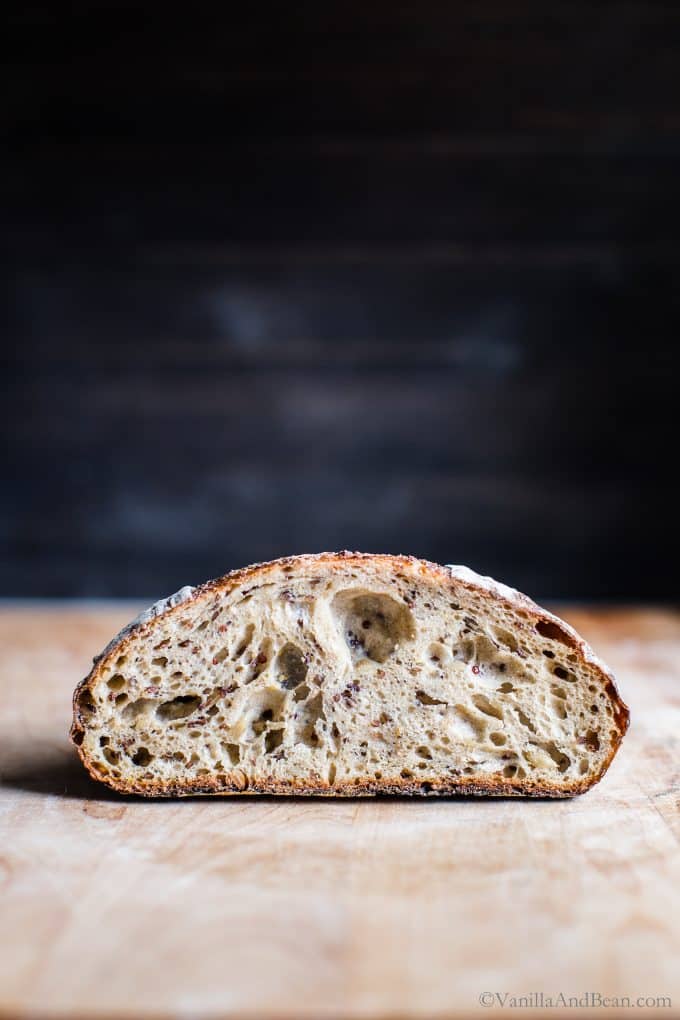
Table of Contents
Celebrating Multigrain Sourdough Bread
If you love Sourdough Recipes, you’ll enjoy this crusty, flavorful seedy loaf. It’s a perfect crumb for sandwiches, toast and anything you want to slather on it.
This was the first loaf I made after an eight-month gluten hiatus. I couldn’t believe how resilient the sourdough starter was after having been neglected for far too many months. After all, I was focusing my efforts on a gluten-free sourdough starter and bread recipe, which you can now find here: my gluten free starter and gluten free sourdough bread.
But, I’m thrilled to be back to my glutenous ways and excited to share more sourdough recipes with you!
This Recipe Is:
- seedy
- has a sturdy crumb for sandwiches, toast and slathering all the things
- bulk fermented overnight
- quick room temperature proof
If you have sourdough starter discard, you can use it in these Olive Oil Sourdough Crackers.
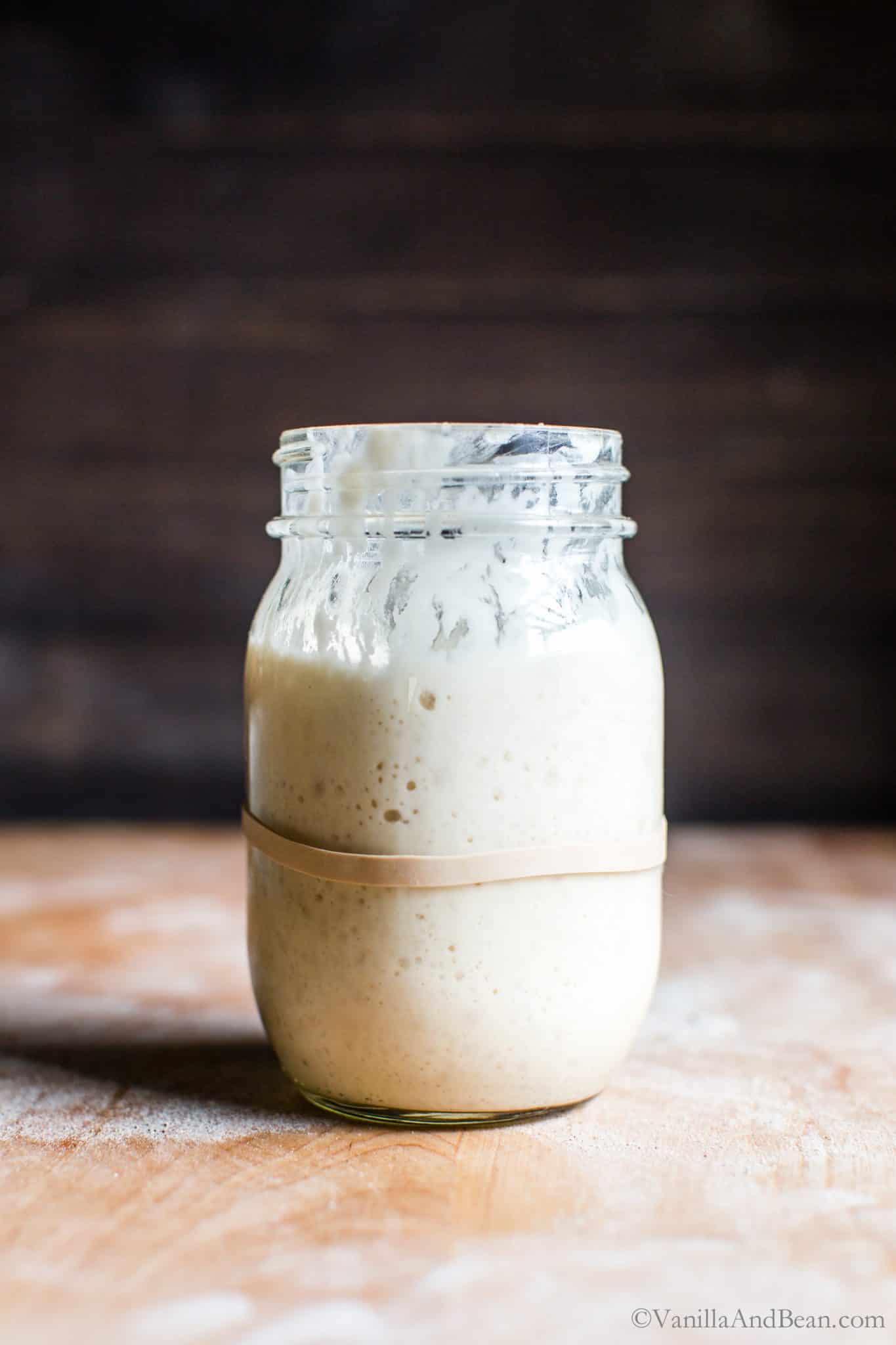
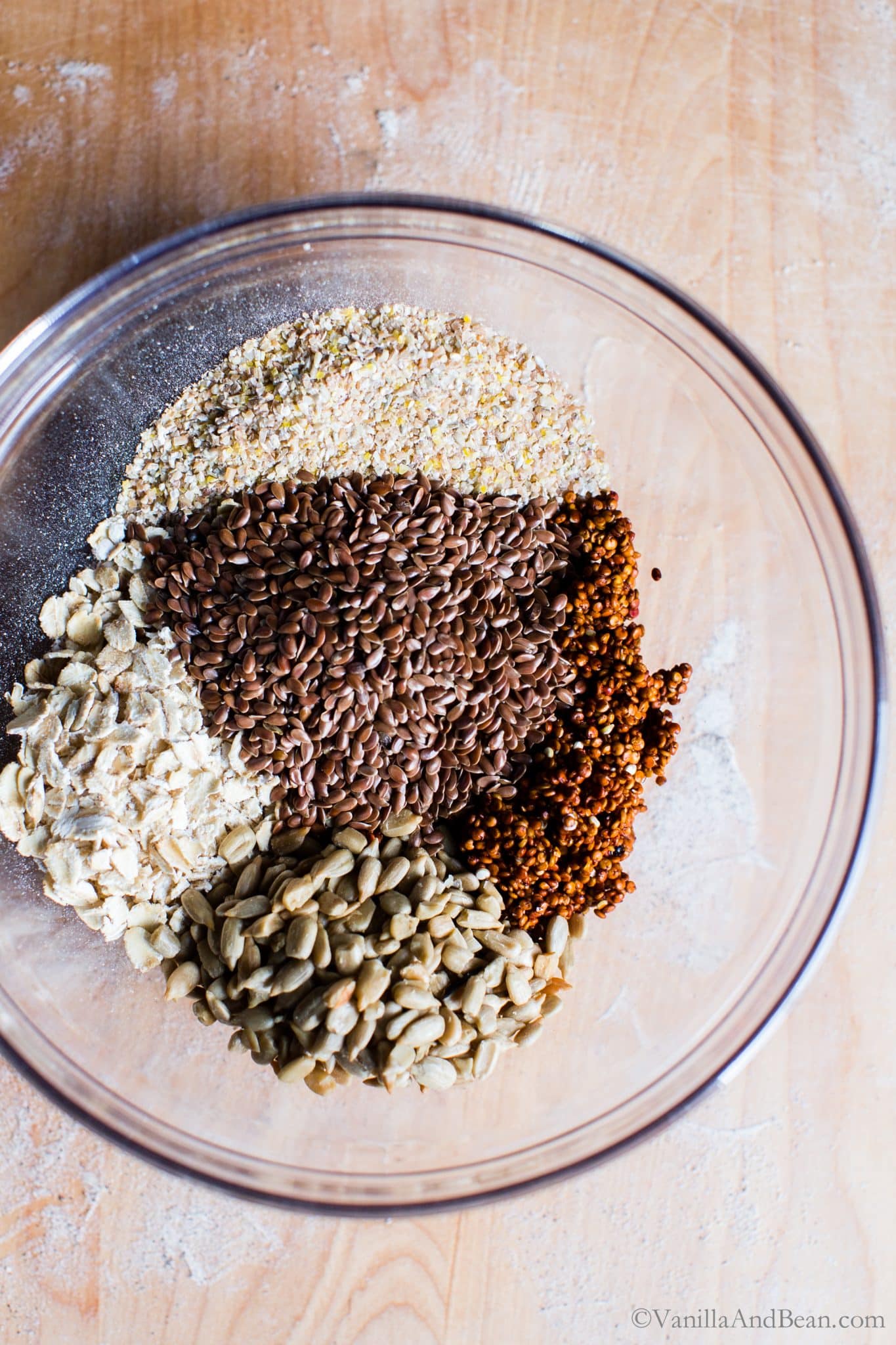
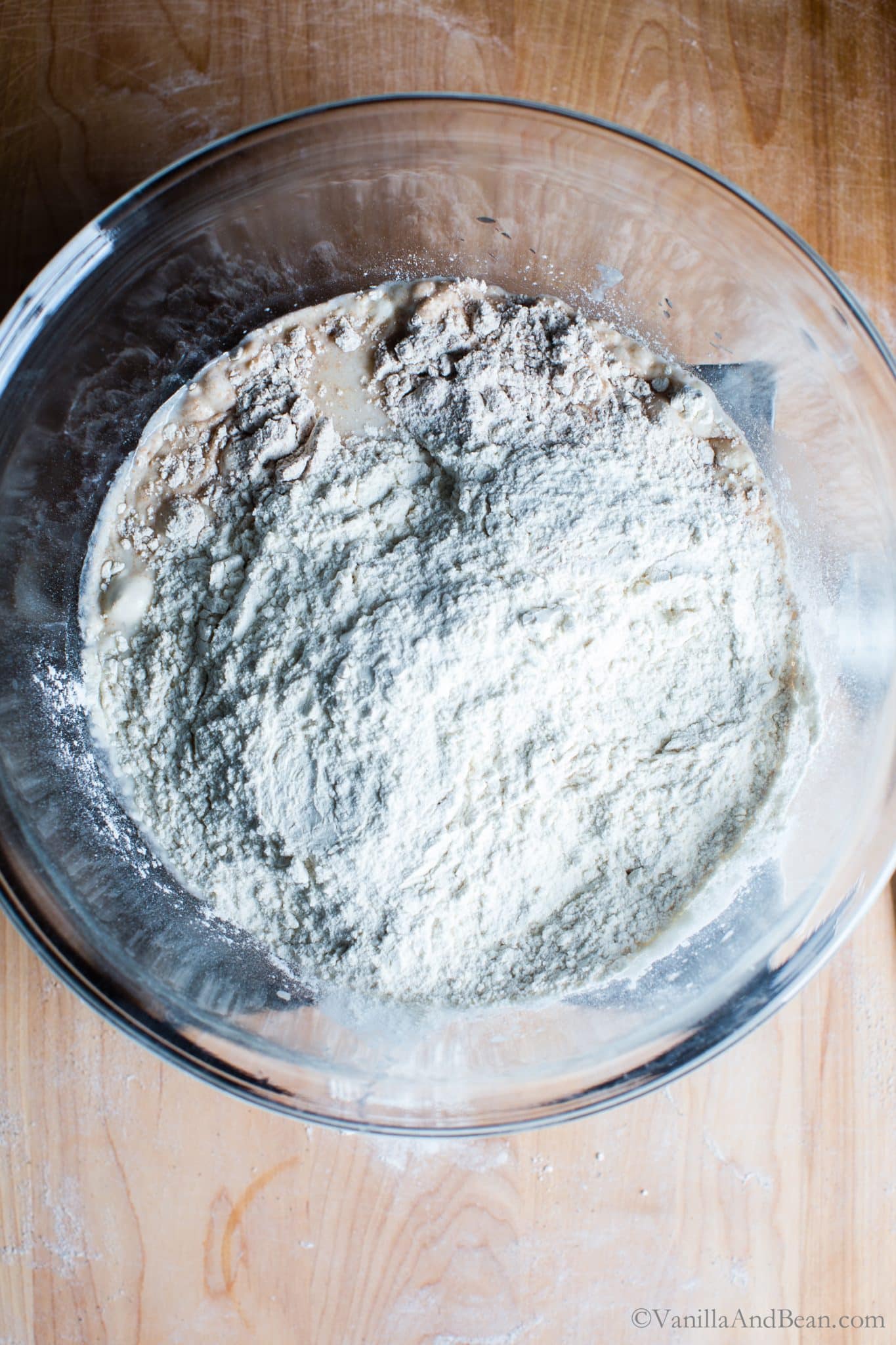
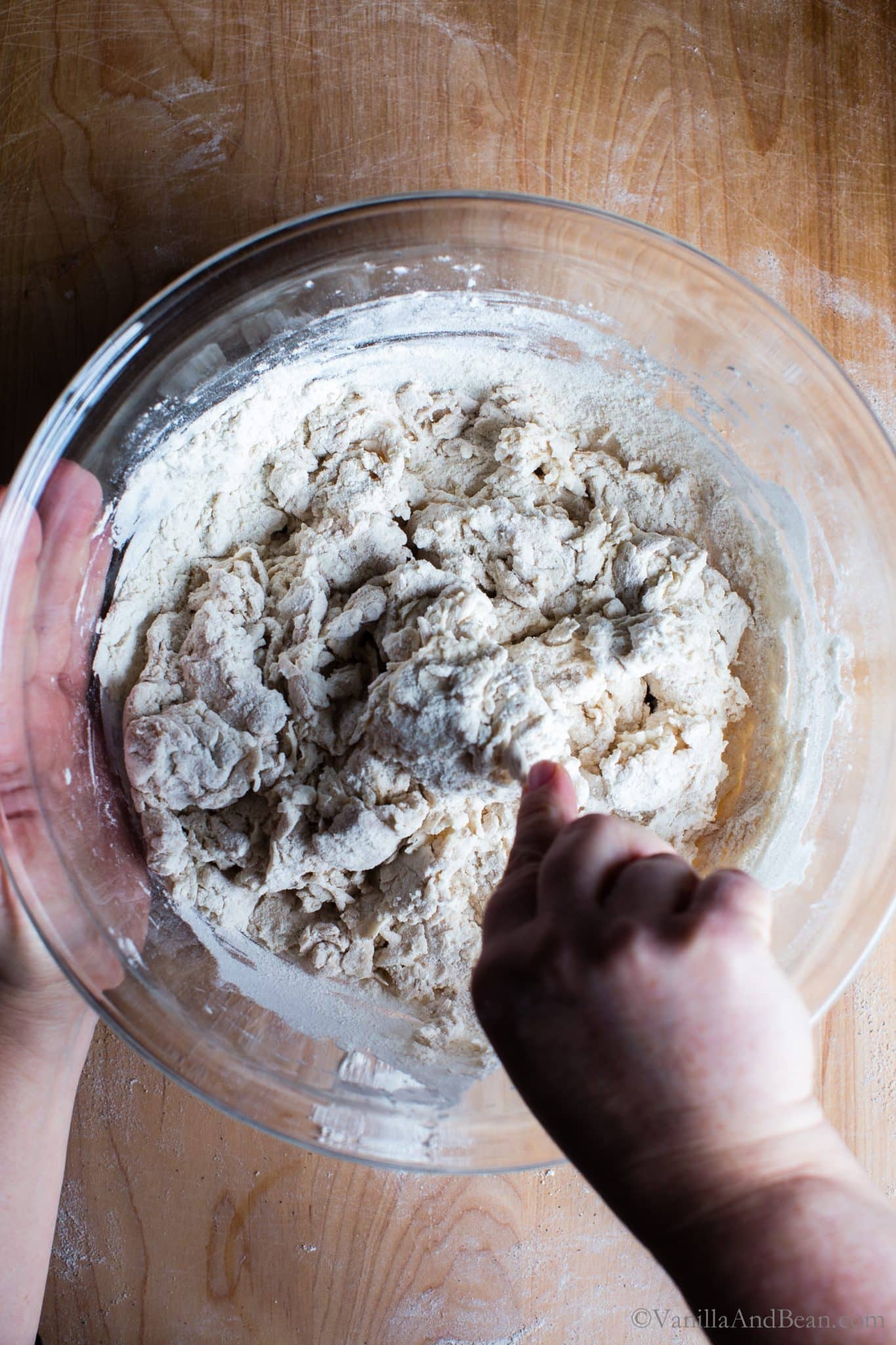
Recipe Inspiration
This seeded sourdough bread recipe is an adaptation on my Yeasted Multigrain Sandwich Bread, a bread I made often before learning how to make sourdough bread. Chock full of grains, including a 10 grain cereal, oats, and quinoa, I also add sunflower and flax seeds to create more texture and flavor.
Making sourdough bread isn’t hard, but, it’s a process that takes a little planning and practice. I used to say I think about sourdough longer than it takes me to create a loaf. And while this was the case at one time, now that I know how to make it, manipulate the rise time through retardation if needed, shape and proof the dough, and bake sourdough, the process doesn’t seem so daunting anymore. Its become closer to second nature, and I don’t think about it as much. A little more brain space is always good!
If you love sourdough recipes, check out my Sourdough Discard Recipes collection. I know you’ll find something new to love!
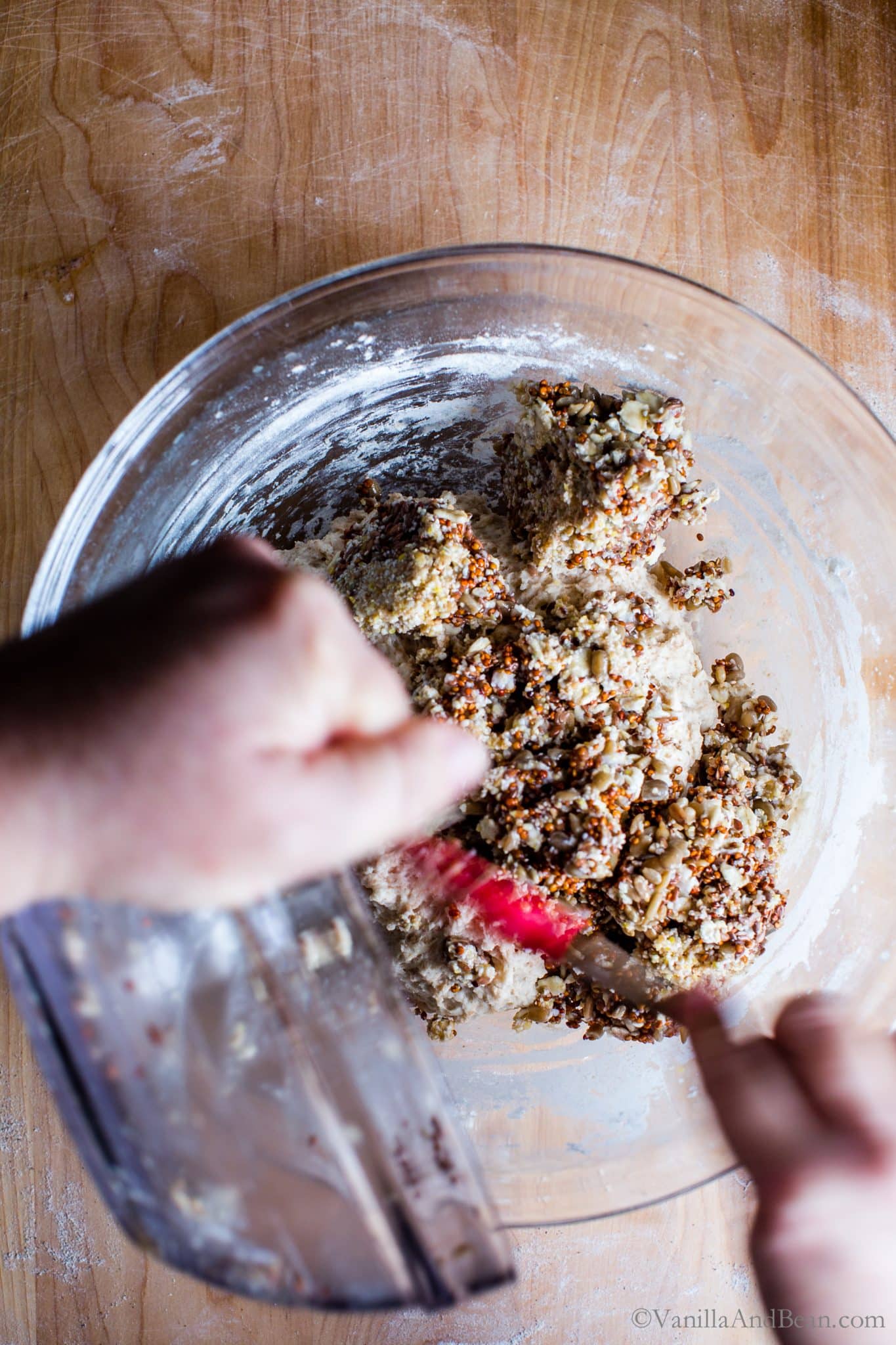
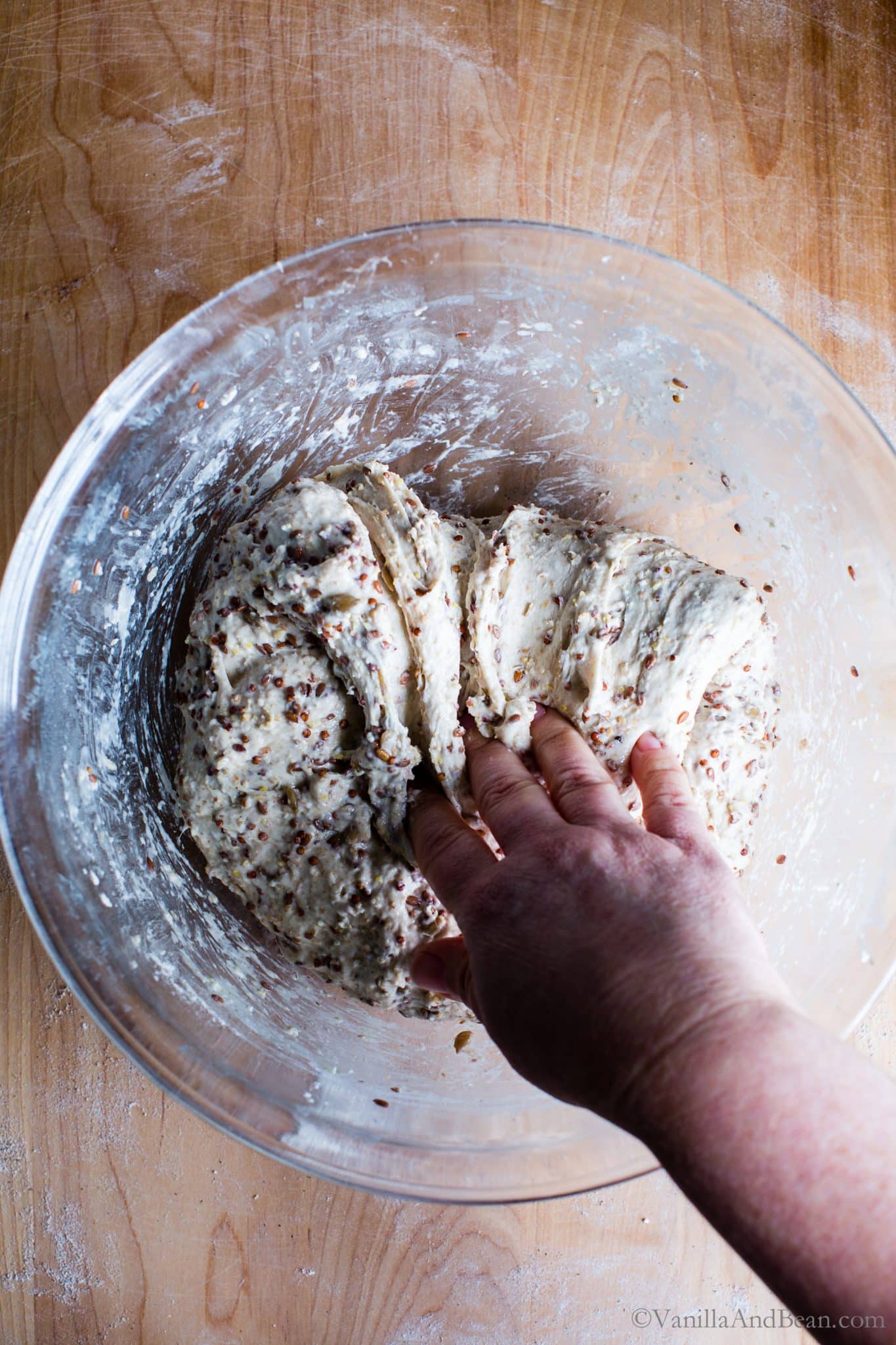
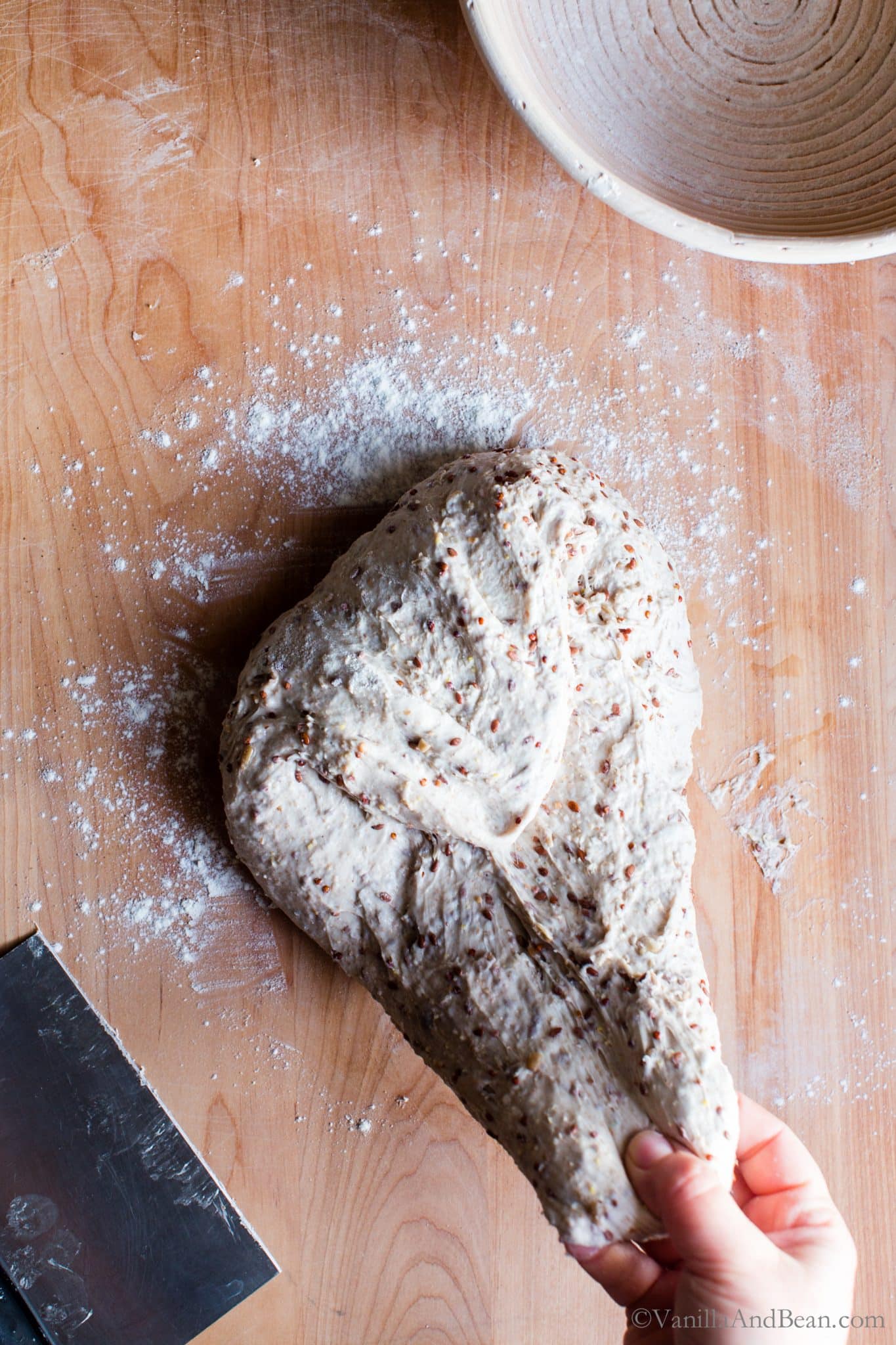
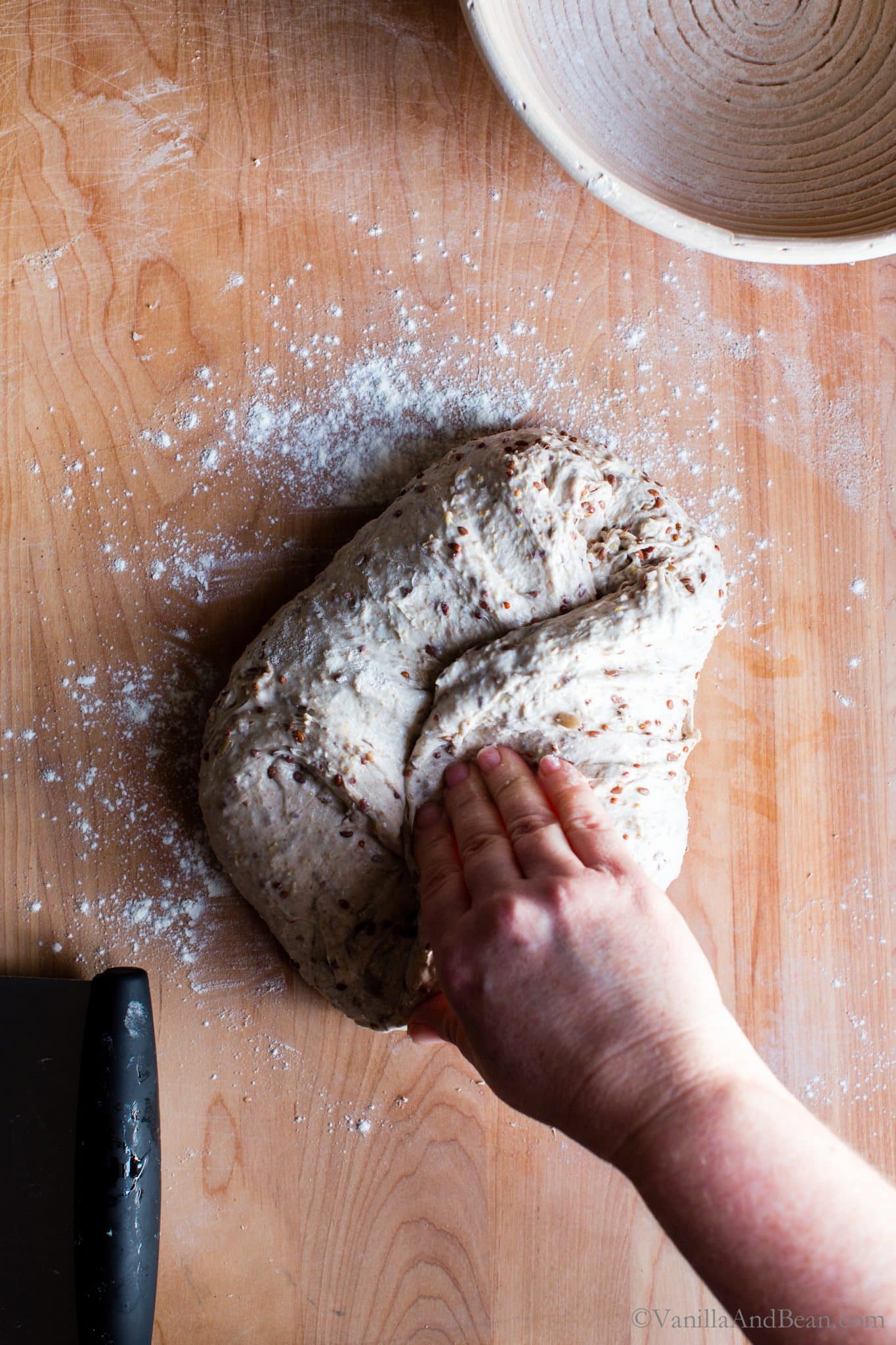
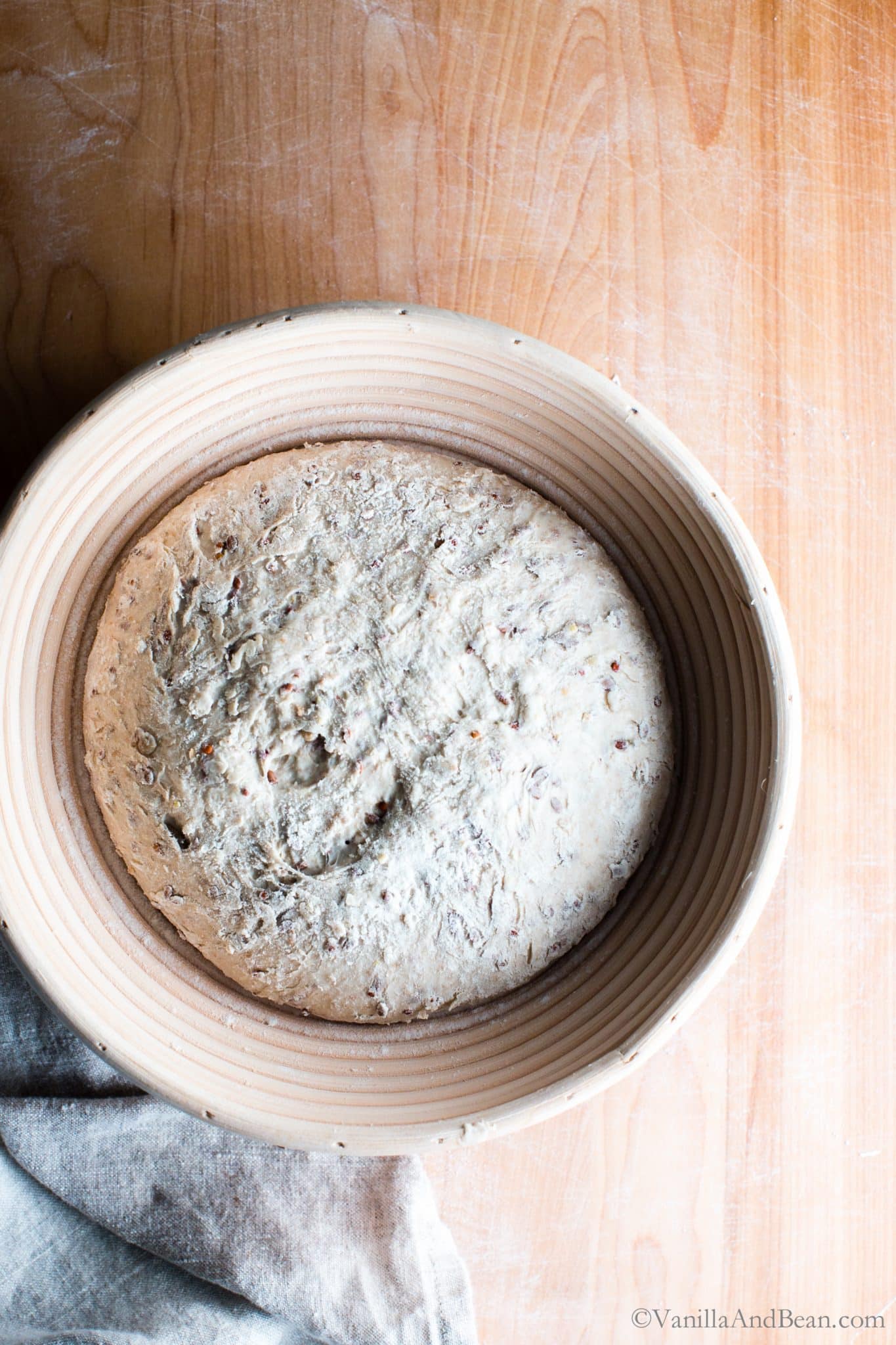
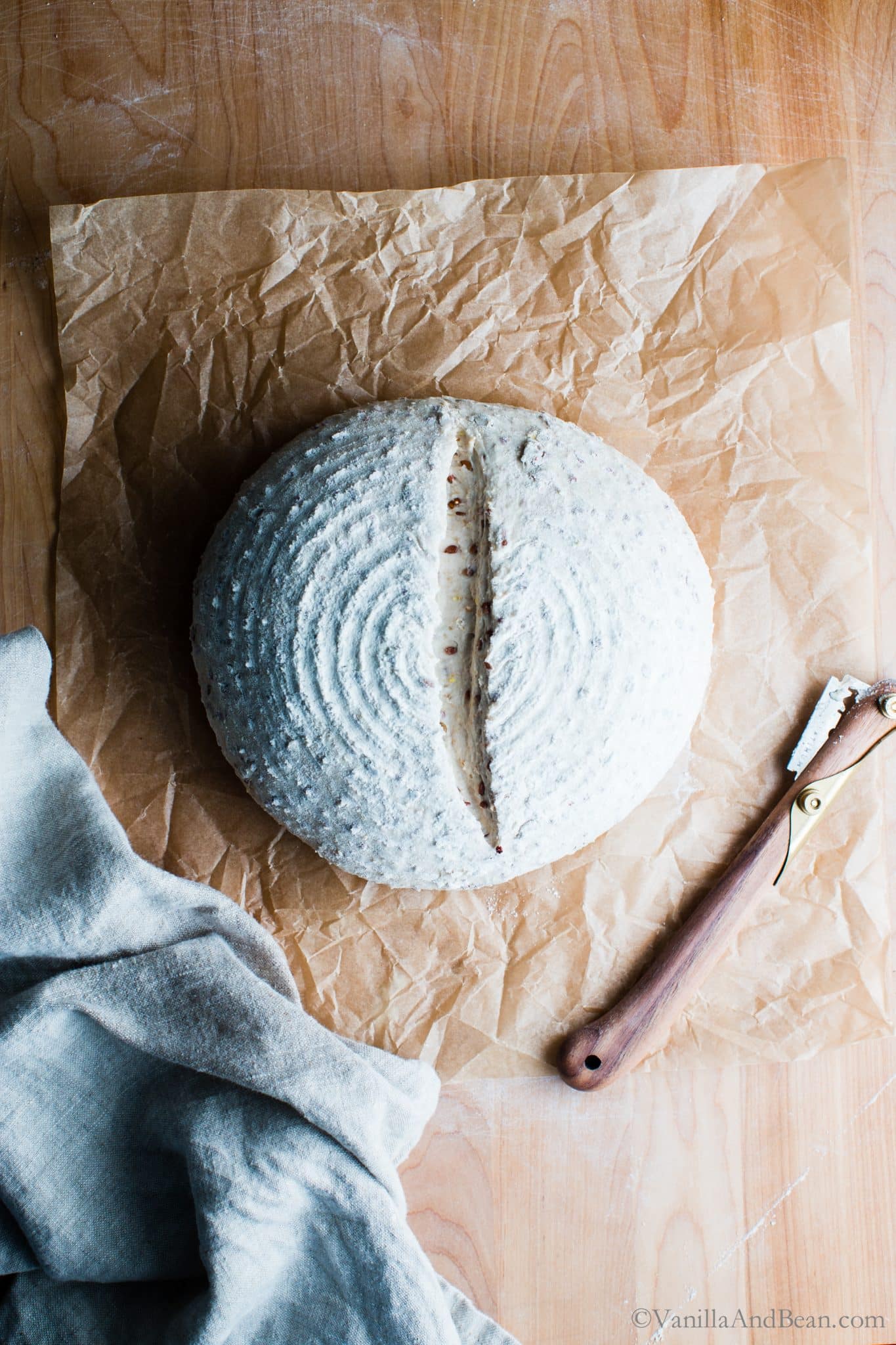
Quick Guide: How to Make Seeded Multigrain Sourdough Bread
The process is pretty straightforward but it takes a bit of planning. I typically mix the night before and bake early on a weekend morning because I have a bit more flexibility then. While you sleep, your little dough baby is growing! Here’s how to make it (see recipe card below for full details):
- First, in the evening, prepare the soaker by pouring hot water over the mixture of seeds and grains.
- Second, mix the dough using a previously fed, active and bubbly sourdough starter, water and a mixture of bread and whole wheat flour. Rest the dough for 30 minutes.
- Third, mix in the soaker, mixing and incorporating the grains and seeds into the sticky dough. Rest the dough for 30 more minutes.
- Fourth, fold the dough. Begin bulk fermentation after the first fold or rest again for 30 minutes and perform a series of up to two more folds resting for 30 minutes between the folds. The additional folds are optional, but are beneficial in building structure and creating a beautiful crumb (pictured in this post). Do it if you have time.
- Fifth, bulk ferment the dough at room temperature for 8-14 hours. The time will depend on ambient temperature, and your specific sourdough starter.
- Sixth, shape the dough into one, 2 lb boule or two, 1 lb boules.
- Next, proof the dough for about 30-45 minutes at room temperature.
- Last, score and bake!
The aroma wafting through the house is so warm and inviting, you’ll want to rip into the bread as soon as it comes out of the oven.
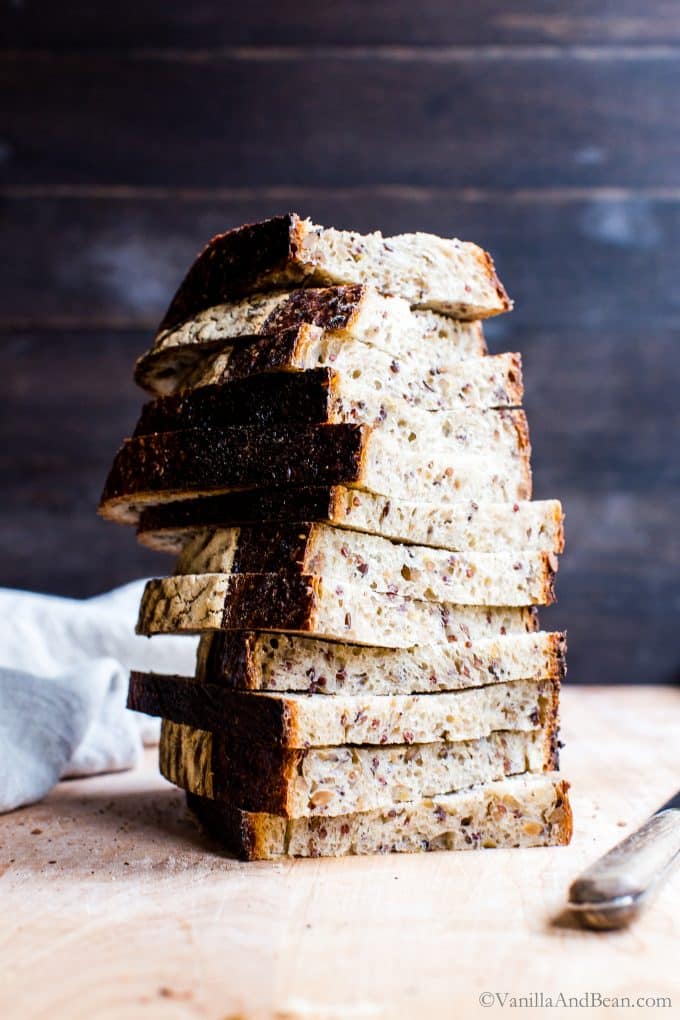
How Long Does it Take for Sourdough to Rise?
- Sourdough rise (bulk ferment) time depends on several factors: ambient temperature and how active your starter is. Also, a firmer dough will take longer to rise than a well-hydrated dough.
- When fermenting at room temperature, bulk rise time in summer will differ from winter rise times.
- An ambient temperature of 70F (21C) will require a bulk rise time of about 8-10 hours. My kitchen tends to be cooler most of the year, but in the winter, it’s downright cold. It’s not unusual for my sourdough to take up to 14 hours to rise during the coldest months.
How To Tell When Sourdough Has Risen Enough
- The bulk fermented (first rise) dough is ready when:
- it no longer looks or feels dense
- is jiggly when the bowl is shaken
- has about doubled in size
- you may see a few large bubbles on the surface of the dough
Why Allow The Bread To Cool After Baking
To complete the cooking process, sourdough bread needs at least an hour to an hour and a half to rest at room temperature. The crust will continue to develop as the sourdough cools as well. However, I won’t deny that I’ve ripped into a few loaves before the hour was up. It’s sublime with a slather of butter.
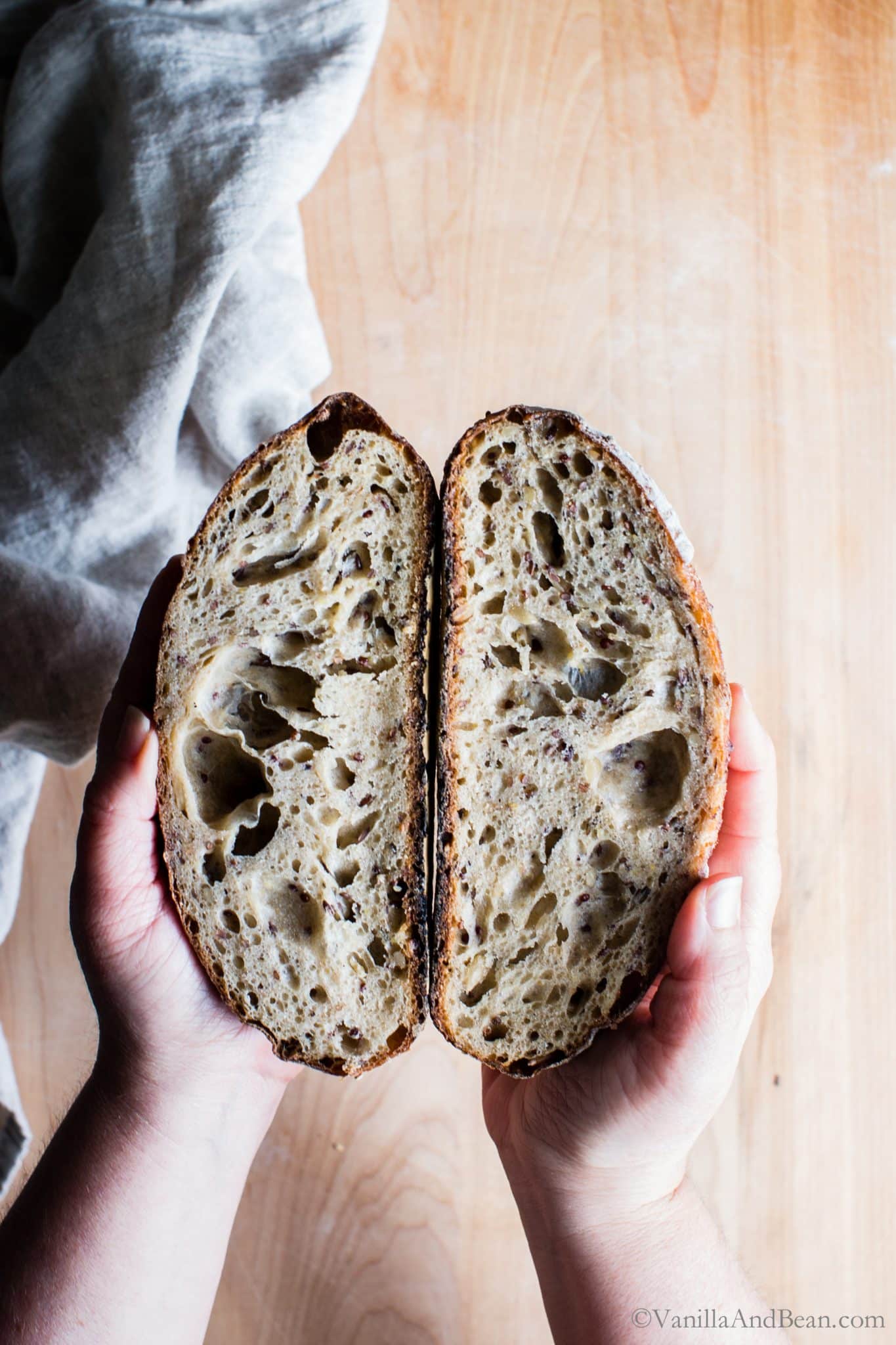
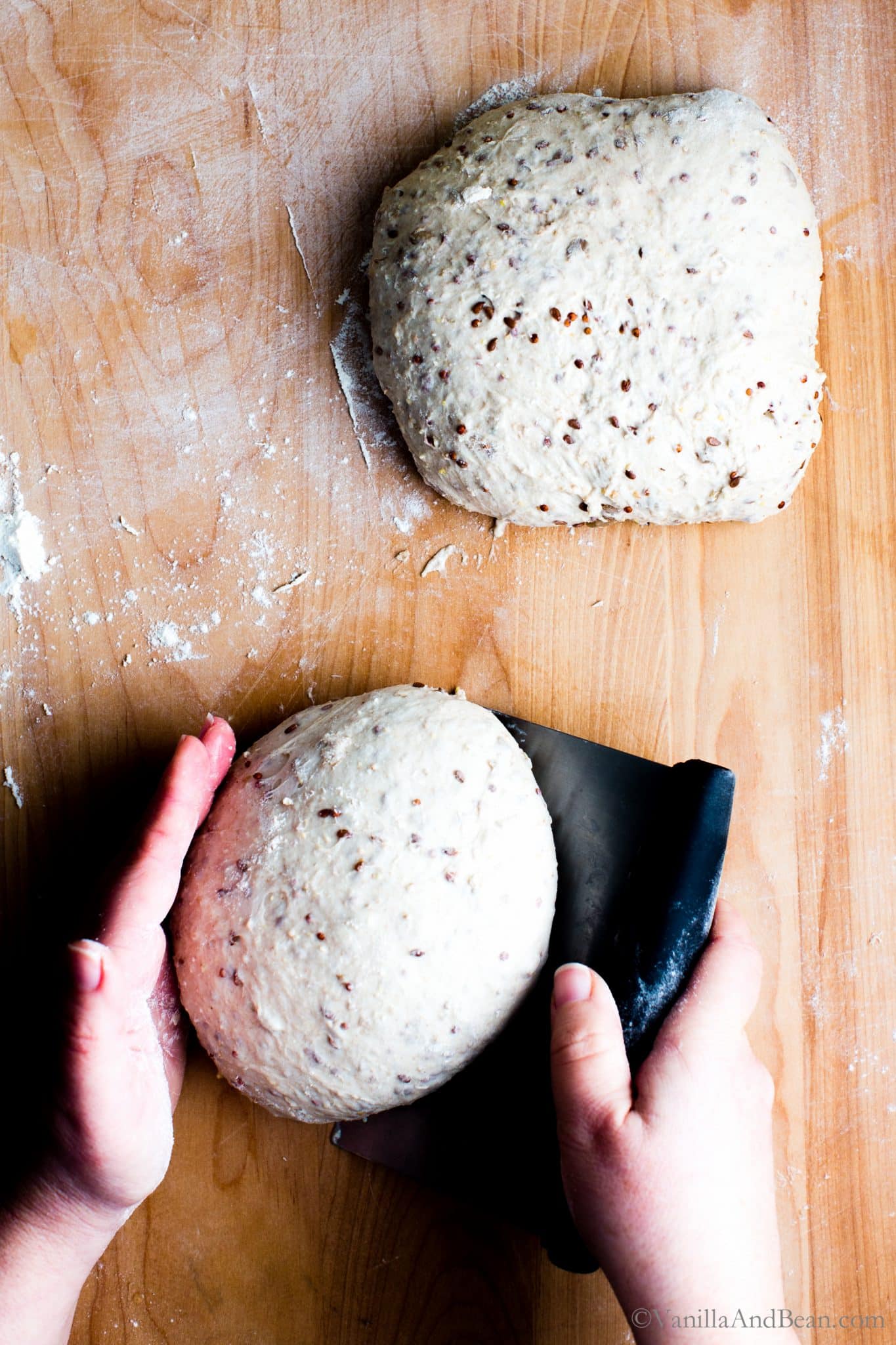
How Do You Store Sourdough Bread?
- Store sourdough bread at room temperature on a cutting board or counter, cut side down. Although freshest the day made, it will store this way for 3-4 days. If you need to cover the bread, place it in a paper bag.
- Refrigerating bread dries it out and will ruin its texture.
- For longer storage, place the bread sliced or whole in a freezer bag and freeze for up to two weeks.
What is the Best Vessel to Bake Sourdough Bread In?
I use two vessels to bake sourdough bread. One is a 10″ cast iron skillet with deep dish skillet for a lid and the other, a 7 quart Staub Dutch oven. I recommend either or both, but I’ve noticed the Staub bakes the bottom of the bread darker than the cast iron, sometimes it’s burnt. This may have to do with the vessels’ differing materials.
UPDATE (5/20) Burnt Sourdough Bottom: After testing various methods to remedy the too dark bottom problem, as commenters have mentioned on this sourdough recipe (and on many other non V&B recipes – this is not uncommon in the sourdough world), I’ve finally found the simplest solution ever (duh!). Simply place a sheet pan on the oven rack under the rack your baking vessel is setting on. This helps protect the vessel from the most intense heat of the oven. The two images below show one of the boules I baked using this method.
Prior to doing this, I used a method I learned from The Perfect Loaf who suggests using a double layer parchment or a dusting of course cornmeal alone or under the parchment. Doing this offers a bit of distance between the bottom of the dough coming in direct contact with the base of the vessel. But I still had a bit of too dark bottom. Now, I exclusively use the sheet pan method.
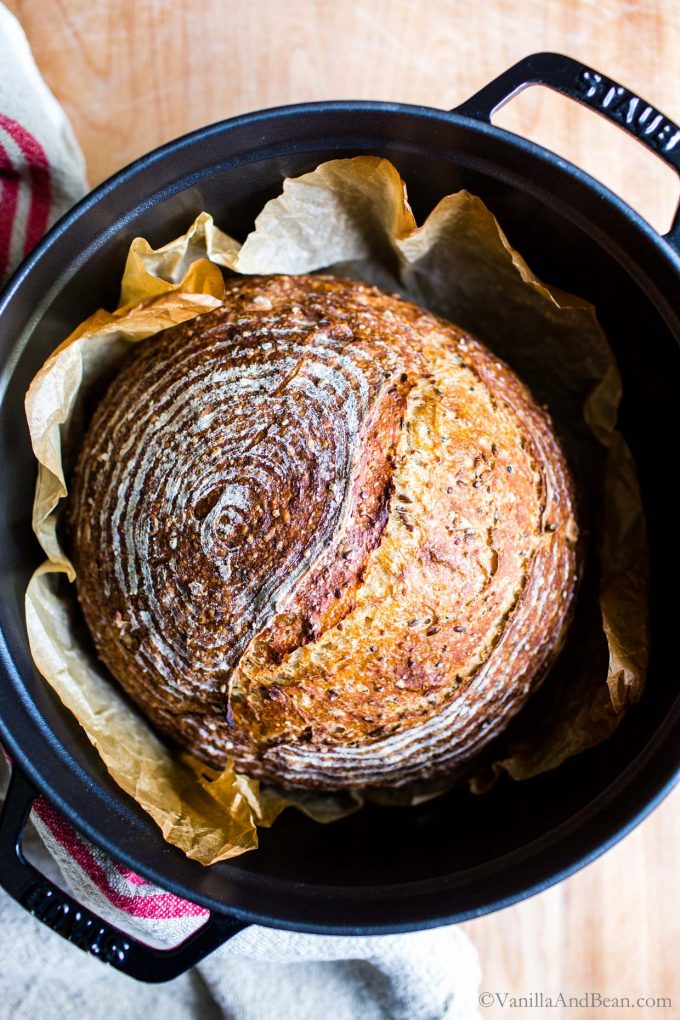
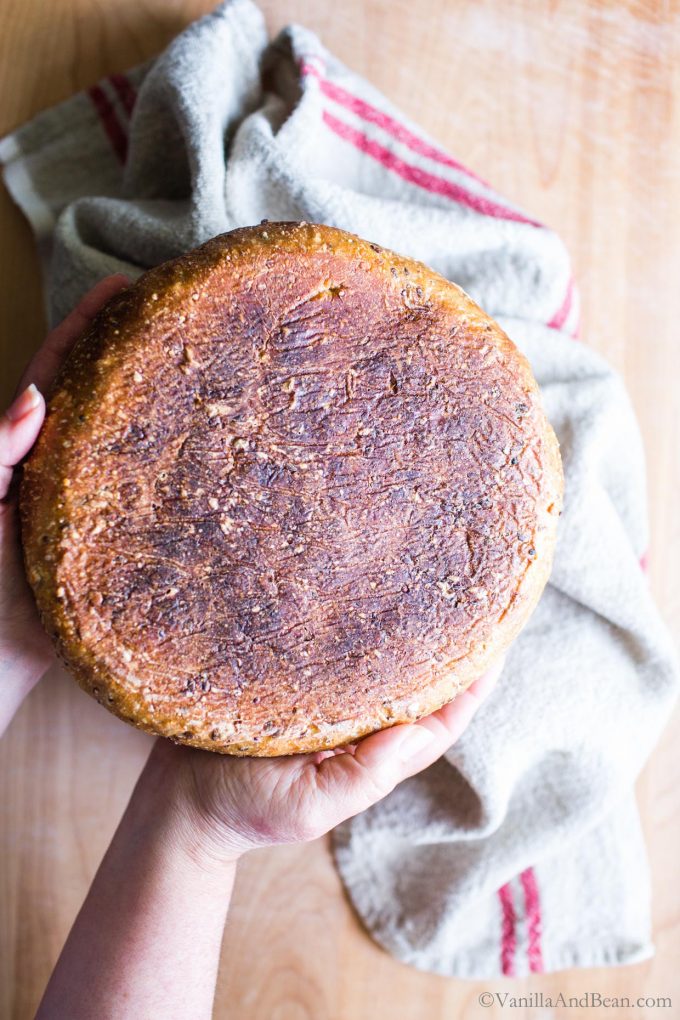
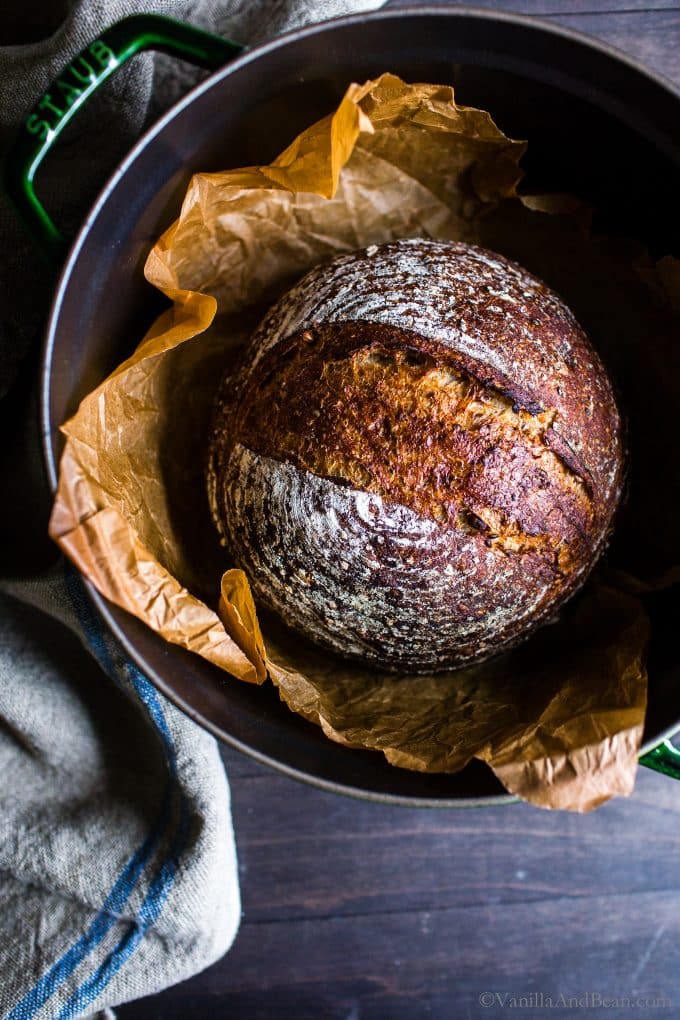
Expert Tips
- Because kitchen temperatures vary, use the time suggestions in the recipe as such. Let the bread guide your process rather than the clock.
- Mini Boules? Yes please! This sourdough recipe can be made into one, 2 lb boule or two, 1 lb boules. The one-pound boules are fabulous for bread or dipping bowls, or if you’re baking for one or two and want to freeze or give away the second loaf. Both sizes make decent size sandwich bread.
- TIP: This recipe calls for 10 grain cereal. If unavailable, you can use 7 grain or even 6 grain cereal. Also, a combination of polenta, millet, quinoa, and/or amaranth can be subbed, but the flavor will be different.
- Whole wheat bread flour can be difficult to find. If unavailable, this recipe will also work using whole wheat flour with similar results. Whole wheat bread flour renders the dough a bit easier to work with, however (more stretchy).
- Freezer friendly? Yes please! Store baked bread in a freezer bag, either whole or sliced for up to two weeks. Thaw at room temperature or if used for toast, toast directly from freezer to oven.
- For a tutorial on how to make a sourdough starter, see my post on how to make a sourdough starter.
Makers Notes
So happy to read y’all are enjoying the bread in the comments below. Keep those tips comin’! Here are excerpts from the community:
- Emily Commented: “…used apf (all-purpose flour) instead of bread flour, but the result was still stunning, I got a gorgeous rise and soft moistness with a chewy crust.”
- Marilyn Commented: “I used a 5 qt DO for 1 loaf (without splitting the dough in half) and it was fine!”
- Dara Said: “I didn’t have all the ingredients the recipe called for so I used a combination of sunflower seeds, oats, hemp seeds, flax seeds, and millet.”
- Samantha Commented: “I did 3T each of quinoa, rolled oats, pumpkin seeds, sunflower seeds. I did 3 cups all-purpose unbleached white flour and 1 cup whole wheat bread flour and 1/2 cup spelt. I also subbed honey for maple syrup.”
- Robyn Said: “I made a few changes: all quinoa instead of cereal grains, hemp seeds instead of flax and added pumpkin seeds and sunflower seeds.”
- Nichole Said: “I’ve taken this one, and increased the proportion of whole grains and it’s so yummy. I use 60 grams whole wheat bread flour, 240 of bread flour, 130 whole wheat flour and 70 of buckwheat. I also halved the maple syrup.”
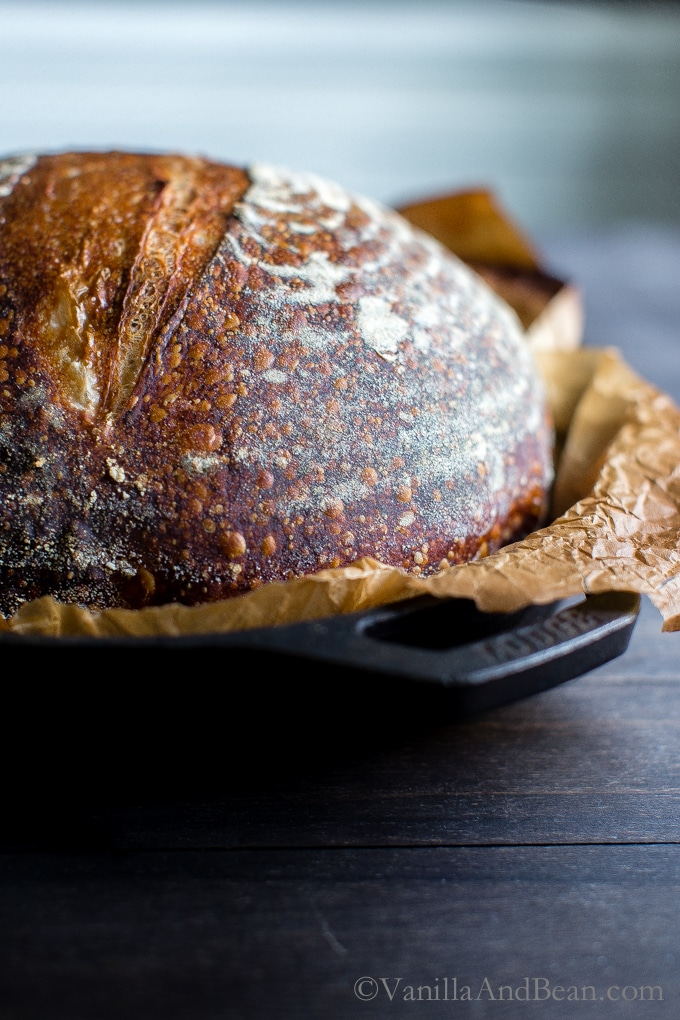
Looking for an easy sourdough bread recipe to start with? Check out my Everyday Sourdough or Multigrain Gluten Free Sourdough Bread post.
My Sourdough Toolkit (affiliate links):
-
- Glass Mixing Bowl
- 7 Quart Dutch Oven
- 10″ Cast Iron Skillet with Deep Dish Skillet for a lid
- Bench Scraper
- Parchment Paper
- Food Thermometer
- Lame – for scoring the dough
- Banneton(s)
- Digital Scale
More Sourdough Recipes to Love
- Sourdough Hamburger Buns
- Cranberry Sourdough Bread with Orange
- Rustic Sourdough Bread
- Soft Sourdough Dinner Rolls
- Maple Oat Sourdough Sandwich Bread
- Sourdough Pizza
Seeded Multigrain Sourdough Bread Recipe
Ingredients
For the Soaker:
- 1/4 C (40g) 10 Grain Cereal *(see note)
- 3 Tbs (25g) Rolled Oats not quick
- 2 Tbs (25g) Red Quinoa rinsed
- 2 Tbs (25g) Flax Seed
- 2 Tbs (25g) Hulled Sunflower Seeds unsalted
- 3/4 C (155g) Hot Water about 150F (65C), or soak the grains and seeds overnight in room temperature water
For the Dough:
- 1/4 C (50g) Sourdough Starter previously fed, bubbly and active
- 1 1/3 C (300g) Warm Water about 80f (26c)
- 2 1/2 Tbs (50g) Maple Syrup
- 3 C (400g) Bread Flour
- 1/2 C + 1 Tbs (100g) Whole Wheat Bread Flour or whole wheat flour
- 2 tsp (16g) Fine Sea Salt
Instructions
For the Soaker:
- In a medium mixing bowl add the cereal, rolled oats, quinoa, flax seeds, sunflower seeds and water. Set aside.
For the Dough:
- Mix the Dough: In the evening, whisk the starter, water and maple syrup together in a large bowl with a fork. Add the flours and salt. First, mix with a fork, the dough will be shaggy. Then mix by hand, mixing, folding and pushing the dough until the flour is fully incorporated and no dry bits are present. It will seem dry at first, but the more you work the dough, the more hydrated it will become. The dough will feel stiff and it will stick to your fingers as you go. Do this for about 3-4 minutes. Use the fork to scrape off the dough on your fingers as much as you can. Cover bowl with a damp tea towel. Set a timer for for 30 minutes and allow the dough to rest for 30 minutes. Now is a good time to feed/refresh your starter.
- Incorporate the Soaker: After the dough has rested, mix in the soaker. To do this, dump the soaker on top of the dough and begin kneading and folding the dough over and on top of itself, incorporating the ingredients of the soaker. Do this for about 1-2 minutes or until the soaker is evenly distributed in the dough. It will seem like a lot of added bits, but as you work the dough and as the dough develops through fermentation, the soaker will incorporate. The dough will be stiff, wet and sticky. If adjusting water or flour, now is the time to assess the dough and adjust as needed. Set a timer for 30 minutes and allow the dough to rest for 30 minutes.
- Fold the Dough: After the dough has rested, fold the dough. To do this, grab a portion of the dough while it remains in the bowl, stretch it up and fold it over, pressing your fingertips into the center of the dough. You'll notice the dough is less stiff and more workable at this point. Repeat, until you've worked your way around the dough. This is the first fold, and you can stop here and begin bulk fermentation, but If time permits, and optimally, you'll want to repeat this fold two more times as it improves the final dough's structure and crumb. Allow for about 30-45 minutes each between folds.
- Bulk (fermentation) Rise: After the last fold, cover the bowl with a damp towel and allow to rise overnight at room temperature. This will take about 8-10 hours at 70F (21C), but in a cooler kitchen the dough can take up to 12-14 hours to rise - this is the norm in my chilly kitchen. The dough is ready when it no longer looks dense, is jiggly when the bowl is shaken, and has about doubled in size.
- Shape the Dough: In the morning, and with damp fingertips, coax the dough into a floured work-surface. If making two boules (1 pound / 453 grams - each), moisten the cutting end of the bench scraper and cut the dough in half. For one or two boules, with moist fingers, take a portion of the dough, gently stretch it towards you and fold it over towards the center and pressing it down gently. Repeat this process until you work the dough all the way around. Using a bench scraper flip the dough over and let rest for 10 minutes. Meanwhile, line an 8-inch (20cm) bowl with a towel or lightly flour a banneton (or two as needed). Scrape any excess flour away on your work-surface using the bench scraper and using a spray bottle with water, lightly sprits the surface of the work-surface. This will help the dough grip the surface and help create a taught dough. With lightly floured hands and using the bench scraper again as needed to help move the dough (the dough is sticky), cup your left hand around the dough and pull the dough toward you in a circular motion with the bench scraper in the right hand, to tighten its shape and create a taught skin. Use the bench scraper as needed to work the dough as this dough is sticky. Re-flour your hands as needed.Once the surface is taut, give it a good dusting of flour and smooth it over the top. With one swift move, use the bench scraper to scoop the dough up and, place the dough into the bowl/banneton, bottom side up. Sprinkle the bottom of the dough with a dusting of flour.
- Second (proof) Rise: Cover the bowl with a damp tea towel and let rest for 30 minutes to 45 minutes. The dough is ready when it looks puffy and has risen slightly but has not yet doubled in size. Preheat the oven to 500F (260C). Arrange a rack in the center of the oven, and another just below it. Place a sheet pan on the bottom rack (see UPDATE just below). Cut a sheet of parchment paper to fit the size of a 7 quart Dutch oven or other large baking vessel leaving enough excess around the sides to transfer the bread to the pot. UPDATE: Burnt Sourdough Bottom: After testing various methods to remedy the too dark bottom problem, as commenters have mentioned on this sourdough recipe (and on other non V&B recipes - this is not uncommon in the sourdough world), I've finally found the simplest solution ever (duh!). Simply place a sheet pan on the oven rack under the rack your baking vessel is setting on. This protects the bottom of the vessel from the most intense heat of the oven.
- Score: To turn the dough out of the bowl/banneton, place the parchment over the dough and invert the bowl to release. Using the tip of a lame or a razor blade, score the dough about 1/2" (8mm) deep and about 2-3" (5-7cm) long on the top or any way you like. Use the parchment to transfer the dough to your baking vessel.
- Bake: Place your lidded vessel on the center rack and reduce heat to 450F (232C). Bake, lidded, for 20 minutes. Remove the lid and continue to bake for 30 -35 minutes, for one, 2 lb boule. If baking two, 1 lb boules, continue to bake lid off for 15-20 minutes. To check if the bread is ready, check the internal temperature of the loaf. It should read between 190F-205F when done. When finished, transfer to a wire rack. Cool for 1 hour before slicing. Sourdough is best consumed on the same day it's baked, but it lasts for 3-4 days stored at room temperature. Store at room temperature cut sides down.This bread freezes beautifully. Store baked bread in a freezer bag either whole or sliced for up to two weeks. Thaw at room temperature. This bread can go from freezer to toaster to make the most delicious toast!

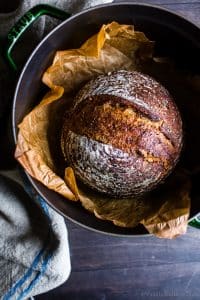
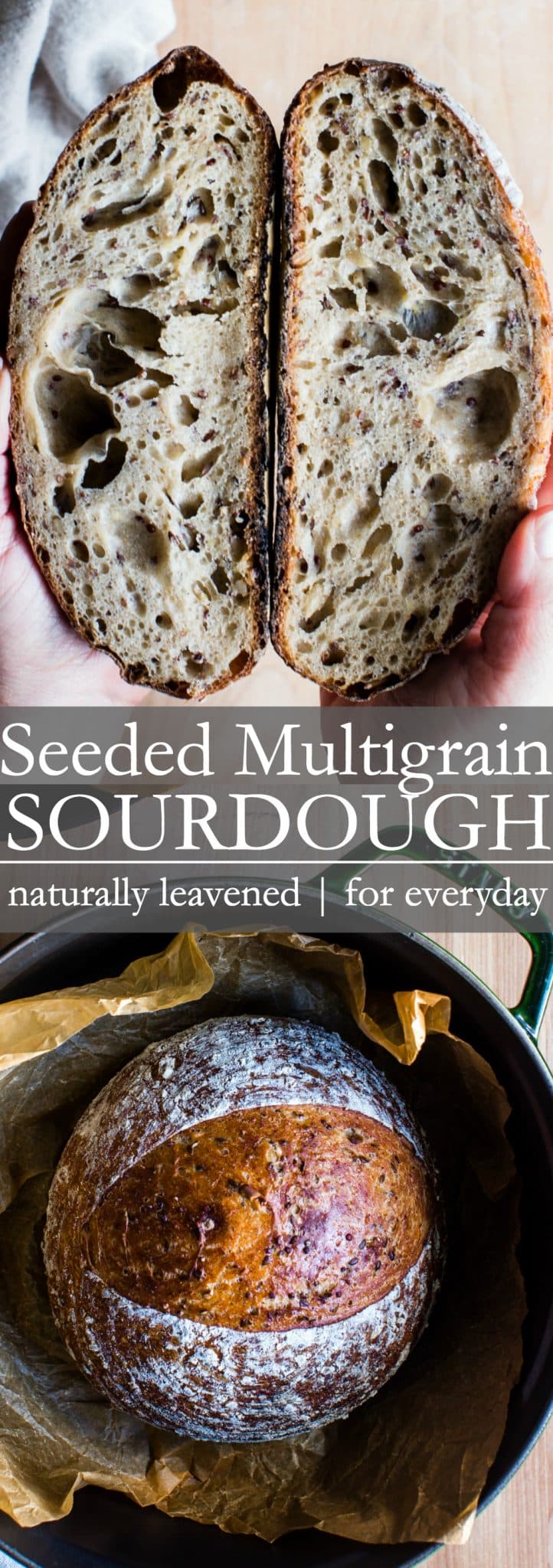 ambient
ambient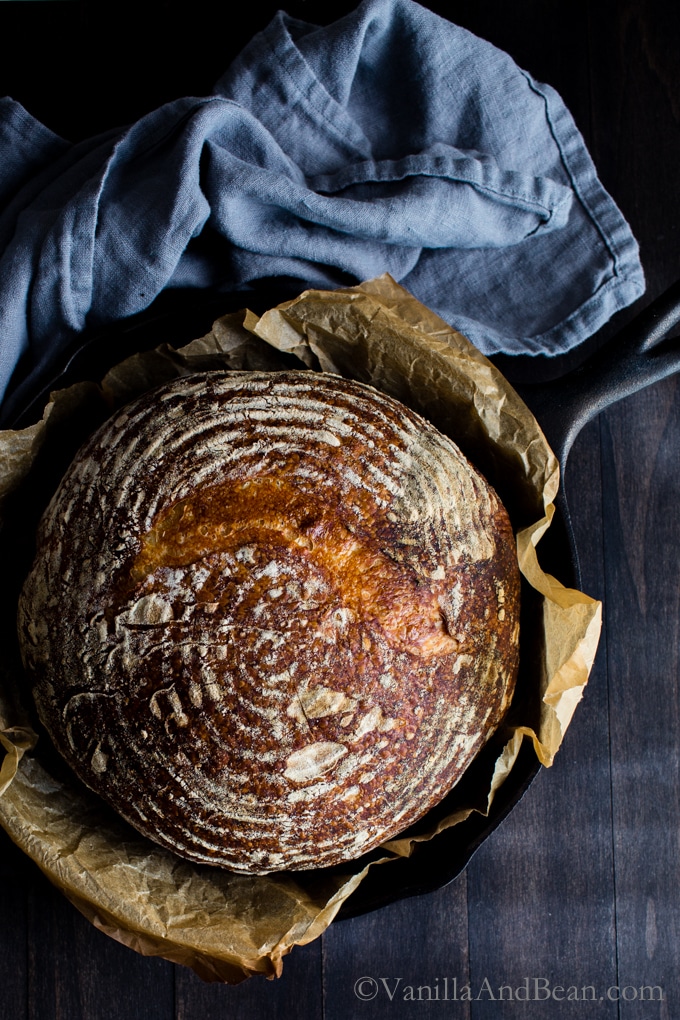
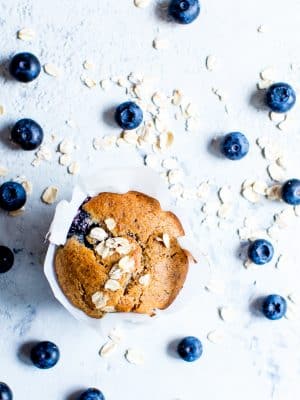
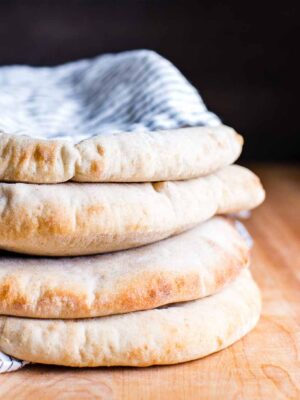
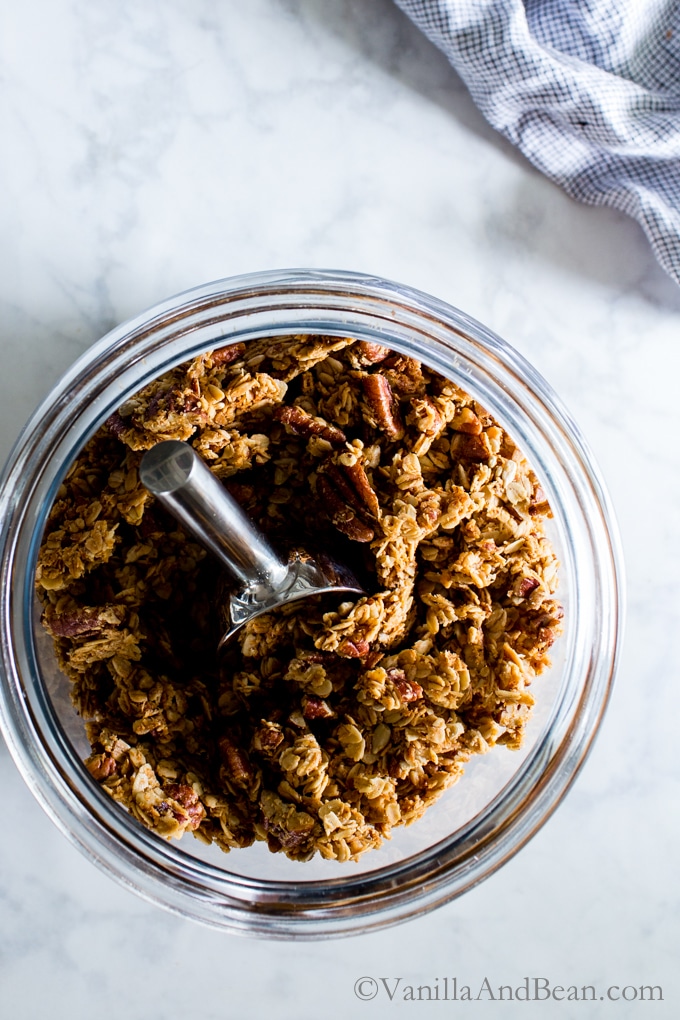
I don’t often leave comments, but this bread is so good it deserves one! I love adding another loaf type to the sourdough rotation! The texture and taste is amazing! I make the soaker like another user recommended with 3T each of oats, quinoa, sunflower seeds, pumpkin seeds. I also usually do the second proof overnight in the fridge for time sake. Can’t wait to explore your blog more! I’m originally from Anacortes so even more excited to learn you’re a Whidbey gal! Thanks.
Hello former neighbor, Casey! I looove Anacortes and visit often, especially for the Farmer’s Markets. Thank you for coming back, leaving a note and sharing your subs! SO happy to hear you’re enjoying the Sourdough. I hope you find more good things to love on the blog :D
This might be the tastiest bread I’ve ever eaten. It’s definitely the tastiest loaf I’ve ever made.. Well done and thanks for sharing the recipe. FWIW, I used steel cut oats in addition to Bob’s cereal, rolled the tops in sesame seeds and baked half in a bread in my dutch oven to see if it would keep it’s shape. It spread a bit too much so I baked the other half in a loaf pan, which worked out perfectly. Even though I used parchment and placed the loaf pan atop a sheet pan, I still had issues with the bottom getting a little too dark. Next time I’m gonna put the loaf pan on a pizza stone to see if that remedies the issue.
Cheers!
Hi Dave! Thank you for your notes, sharing your tips and giving the recipe a go! Those sesame seeds sound epic. Agreed on too dark bottom… sometimes it takes a little finessing to see what works with your particular vessel and oven. Hooray for tastiest loaf!
Hello, quick question about the hydration – given you are adding 155g of water to the seed soak, isn’t this water supposed to be accounted for in your hydration percentage? the current recipe has 155g in the soak, plus 300g of water for the bread, resulting in 455g of water and only 500g of flour. I have seen other recipes reduce the bread water to accommodate for the hydration coming in from the soak. Please advise
Hi Mary! I’m not sure if the soaker should or should not be included in the hydration percentage. I’m sure it is in some way, but I’m not sure exactly how (hydration calculation isn’t something I typically calculate). If you’d like to reduce the bread water in this recipe, please feel free to do so.
Oh my gosh, this bread is SO GOOD!!! I used normal whole wheat flour (not whole wheat bread flour), and it turned out really well! Definitely a keeper :)
HOORAY, Em! SO happy to hear you’re enjoying the sourdough! Thank you for your note and rating :D
I baked this loaf for the first time and wow! What a treat slicing into it for breakfast this morning! Great flavor and texture. I used a mixture of quinoa (20 g), amaranth (10 g), and millet (10 g) to substitute for bob’s cereal mix. This will be a staple in my kitchen! I wonder if there is a way to incorporate sprouted spelt flour?
Thanks for the recipe!
Hi Kyle! Thank you for your note and tips on the soaker. SO happy this recipe is a staple now! I’m afraid I have little experience with spelt, however do know it’s not as thirsty as wheat flour, so hydration would have to be adjusted. By how much I’m not sure. Sounds like I need to get crackin!
Excellent recipe! I’ve made this boule a dozen times now and it always comes out great. How can I get a more crisp outer crust next time?
Hi Fallon! Thank you for your note and making the recipe! SO happy to hear. The crust crisps as it cools, however once the sourdough is cooled completely, the crust begins to soften. Additionally, whole wheat flour tends to soften sourdough. To crisp it up again, you can toast the bread. I hope this helps!
Try a spray of water inside the oven after you’ve removed the lid of your baking vessel
Great recipe! It’s my go to!
Quick question. Have you ever tried to do the final proof of this loaf in the fridge overnight? If so, did you bring it to room temp after you took it out of the fridge in the a.m. or pop it right into the oven?
Hi Leslie! SO happy to hear! I have proofed this loaf overnight. I turn on the oven and just before the oven is ready, I pull it from the fridge, score and bake. I’ve had slightly varying results with the crumb, but always delicious! I hope this helps and you enjoy trying something new with this loaf. Let us know how it goes!
I have made this bread for the past month and it has turned out fantastic every time! Instead of the cereal, I used 2 tbsp of hemp seeds and 2 tbsp of chia seeds. I also do not have a Dutch oven so I used a cast iron pan + ice cube method to create steam. This may be why my bread only ends up needing about a 30 minutes in the oven. It’s not a very sour bread but it’s perfect for me!
Hi Traci,
I’m new to the sourdough baking. can you use any type of sourdough starter for this recipe, or should I tailor it to match the flour I’m going to use? I have a 100% wholewheat starter and i think it wouldn’t it? Thanks and I can’t wait to give this a go.
Hi Sherly! Thank you for your note. I wouldn’t hesitate using your starter. Just make sure it’s 100% hydration. The dough will probably be a bit stiffer due to the added whole wheat, so just be aware of that. I hope this helps and you enjoy the sourdough! Please keep in touch!
Hi Traci, we love the sourdough grain, thank you so much for the recipe. I however encountered some problem that I’m hoping you can help. The first time I tried, the dough was very sticky and while it rose, probably more than double, it didn’t have any shape. I suspect it over fermented during the overnight rest. But boy it rose. Now im making it again, and to circumvent the same issue, I put it inside the fridge, and it didn’t rise at all, probably under fermented. It’s now resting on room temperature, trying to see if it will rise. Do you have any tips? Thank you in advance.
Hi Sherly! For the very sticky dough, try holding out 1/4 C – 1/2 C water next time you mix. This is not uncommon due to local humidity and flour moisture content. This would be something to look for while mixing. Over fermenting can cause the dough to turn into a blob, like you said. Retarding the dough in the fridge is perfect (I do this all the time), but eventually it’ll need to double in size during the bulk phase. So, what I do is bulk overnight in the fridge, then put it on the counter at room temp. the next day to double in size. This generally takes all day because the dough is so cold. If you need to move the dough along, pop it in the oven and turn on the oven light. Make sure the bowl is covered in two moist tea towels. This will warm the dough up quicker and help it rise. I hope this helps, Sherly. Let me know if I can answer any other questions!
I absolutely love this sourdough recipe – it’s seedy, soft, and crunchy on the exterior. I usually make one boule and utilized the trick of putting the sheet pan underneath the dutch oven to eliminate too dark of a bottom. I’ve tried a few different variations with chia seeds and steel cut oats – all come out great if you follow the same grain/seed to water ratio as listed in the recipe. I’ve made a few times without maple syrup and still comes out fine!
This makes me so happy Kristina! Thank you for your note and sharing your tips about seeds and steel cut oats! YUM!
I made this today and it was awesome. Few changes – I can’t find the 10 grain cereal, so just added my own grains/seeds that I had on hand (pepitas, sunflower seeds, poppy seeds, sesame seeds etc). I also skipped the step where you second proof the dough in the banneton – I put it straight into my 4-quart dutch oven, and let it rise for 45 minutes, while heating the oven. I did 20 minutes with the lid on and 40 minutes with the lid off. It was perfect!
Hooray! Thank you for your note and sharing your tips, Elise! I love that seedy mix you created.
This is a keeper! Best whole grain sourdough bread recipe I have tried. The flavor is so good you can eat it plain. Will be making this regularly from now on.
Hooray, HOORAY Kathy! So happy to hear you’re enjoying the sourdough… I’m whippin’ up a loaf today :D Thank you for your note and review!
Love this recipe, thank you! Would it work in a loaf pan like your maple oat sandwich bread (which I also love)? Or could I add seeds to the maple oat instead?
Hi Elyse! Thank you for your note. So happy to hear you’re enjoying the recipe. I’ve not made this in a loaf pan, but comparing it to my maple oat recipe, it’s a bit bulkier in ingredients with the soaker. So, I’m not sure it would work. If you give it a go, please let us know how it turns out!
I tried making it in 2, 9 X 5 loaf pans. They turned out great!! Nice spongy texture! The only change I made was cooking the loaves for 35 min at 450, then for 10 min at 400. Not sure if that was necessary but there were no burnt bottoms, which was nice!
Hi Catherine! Thank you for your note and sharing your tip. Hooray for two multigrain loaves and no burnt bottoms! Perfect for sandwiches!
I haven’t tried to eat it. But the top of my bread didn’t brown at all while the inside hit the recommended 199 – 205 Fahrenheit.
I ended up turning the boiler on once they had cooled just to harden the very soft top. Any idea on how I can fix this?
Thanks in advance!
Hi Gurk! Oh my…. I’ve never seen or heard of this before. I’m sorry I’m unable to help troubleshoot.
Do you put the dutch oven in the preheat 500F oven for 30 minutes before you even add the dough from the proofing bowl to the dutch oven? Other recipes call for preheating a covered dutch oven before adding the dough.
Hi Frances! Some recipes call for preheating the DO. I do not find it necessary, but you can certainly do it if you like.
I love the taste of this bread very much! Though mine turned out with 1/2 the volume your’s did, and too dense. Fortunately, it was still eatable, so it is not wasted. But what did I do wrong? For the soaker I left out 2 Tlbs. of flax seed. And I used Hodgmill Multi Grain Cereal instead of Bob RedMill 10 grain cereal. I added 2 Tlbs more of flour after the first 30 minute rest, because it seemed way too wet, and the dough still very sticky and continued to just spread out after each fold. How could I correct this in order to get more volume and fluffier loaf?
Hi again! I’m sorry to hear your sourdough didn’t turn out as expected. Your subs sound fine. Please note that sourdough is a process and takes practice to refine your process. It sounds like the dough may not have bulk fermented long enough. How long did you ferment and at what approximate temperature? As indicted in the recipe, add more flour/water as needed to if the dough seems to wet/dry. This is the nature of sourdough. I hope this helps and you keep practicing!
I had been struggling with my sourdough for MONTHS. No longer. This is such an excellent recipe. Super detailed and thorough…just what I needed. What a delicious loaf. Thank you thank you thank you!
Hi Kay! Thank you for your note and rating – it makes me SO happy!
I’m so excited to try this recipe but I only have a 6 qt Dutch oven. Is that big enough? I’m not sure what will be the best way to bake if I split it and made 2 loaves instead because of only having 1 vessel to bake it in. Please help. I’d love to make this ASAP
Hi Maria! I’m afraid a 6 qt DO wouldn’t be big enough for one full size boule simply because it may inhibit oven spring and affect the overall shape of the boule. If you make two smaller boules, while one is baking, place the other in the fridge (in a proofing vessel, covered with a damp tea towel) until your vessel is free to use again. I hope this helps and you enjoy the recipe, Maria! LMK if you have any other Qs.
Finally got a big enough DO to bake this bread. It was perfect. My husband loved it too and said he wouldn’t mind eating it more often. It was fairly easy for a new sourdough bread baker. This was only my 3rd sourdough bread to bake. Thank you so much for the detailed instructions.
Hoooray Maria! Thank you so much for your note and giving the recipe a go! SO happy to hear of your success and thank you for your feedback :D
Hi! Do you think I could get away with a longer, refrigerated bulk ferment? Like 20hours? I’m thinking mix, S&F a few times, then throw in the fridge around 8pm and take it out the next day after work (~4pm) and shape (admittedly I usually just throw in a loaf pan), proof on the counter for a bit and then bake? I guess all I can do is try, right? :D
Hi Hayley! I wouldn’t hesitate bulking that long in the fridge. You’ll need to allow the dough to double in size however before shaping. And also, it’s easier to shape when it’s room temp. I hope this helps!
This turns out amazing! I have made it with various seeds and grains. The best flavour comes out with adding a tablespoon of fennel seeds in the soaker.
OMG! I just sliced into my first loaf and it definitely is a “slice of heaven”. The slight sweetness from all that seedy and grainy goodness and a bit of maple syrup, I may never make plain sourdough again!!! Only things I had to substitute, because of availability, a mix of quinoa colors instead of all red, 7 grain cereal instead of 10, (i have the 10 ordered) and regular whole wheat flour for whole wheat bread flour. The directions were spot on. Thank you Traci for this wonderful recipe.
Hi Mary! Thank you for coming back and leaving a note! SO happy to hear your bread turned out to be a “slice of heaven!” and thank you for your feedback on the directions. I no longer make plain sourdough unless a friend requests it… this is my everyday bread! Your subs are perfect, and ones I use too. In fact, I’ve not been able to find the 10 grain and have been using 7 grain as well (I’ll add a note).
Hi there
I tried your gluten free sourdough seeded bread & loved it!
I’m going to try this one. I didn’t have the whole grain so subbed red quinoa then added sunflower seeds, pumpkin seeds, flax seeds & oatmeal.
I’d like to add Sweetened dried cranberries But I’m not sure how much to add & if I should put them in the soaker overnight & increase the water? . My seeds are already mixed & soaking so can’t remove them.
Hi Renata! Thank you for your note and giving the GFSD a go! SO happy to hear it was a success. Your subs sound perfect. I love the idea of dried cranberries however I would soak them separately and drain them before adding them to the dough. Otherwise, too much water will be added overall and you’ll have an unshapable blob! I hope this helps and you enjoy the recipe!
This is truly my favorite bread ever! Made it twice. However, mine doesnt get those wonerful holes. Am i doing something wrong?
Hi Ellen! Thank you for your note! I’m so happy to hear you’re enjoying the sourdough. For wonderful holes, if you’re referring to a more open crumb, this isn’t the recipe for that. The crumb on this bread is a tighter crumb with some smaller open holes. Because it contains whole wheat, other whole grains and a lower hydration, the holes are smaller. For more open crumb structure, you’d need a higher hydration. You can play with that, however, higher hydration is more challenging to work with. I hope this helps!
What can I substitute for the maple syrup?
When weighing 50g of shelled sunflower seeds it it WAY MORE than 2 TABLESPOONS?
Hi Windy! I’m sorry about that! Good Catch…. You’re right. It should be 25g! Thank you for your note!
I’ve made this bread six or seven times, now, and it is absolutely delicious with a terrific, crunchy crust. Even when you think it hasn’t risen enough, don’t despair. It has never failed to produce a beautiful loaf.
Hi Katherine! Thank you for you note and sharing your experience. I’m so happy to hear you’re enjoying the sourdough! This is my go-to – we love it too!
I love this recipe, but as a novice sourdough baker I have a few questions.
1. Can I substitute any type of seed into the soaker as long as the weight remains the same?
2. Why don’t you heat the dutchoven? Some of my loaves have been a bit undercooked towards the base, (the middle seems to be fine) so I was wondering if starting the dough in a hot pan would make a difference.
Thanks for your recipes and advice.
Beth from Vermont
Hi Beth! Thank you for your note and giving the recipe a go. Subbing seeds shouldn’t be a problem. Why I don’t heat the DO? I’ve found, when compared, it didn’t matter if I heated the DO or not. And plus it’s just safer (I’ve burnt my wrists/hands way too many times). Not sure about loaves being undercooked towards the base… do you use an external oven thermometer?
By external oven thermometer, do you mean instant read? If so, no, I don’t own one but have been thinking that’s my next purchase.
Have any recommendations?
An instant read would be helpful for measuring the internal temperature of your bread. An external monitors the internal temperature of your oven. Most ovens aren’t accurate (this is the nature of ovens). Knowing the internal temp. you can then make adjustments as needed. I have resources above the recipe card. I hope this helps!
Thank you, just what I thought. I ended up purchasing a Thermapen.
Thanks for all your advice and great recipes.
My 1st time using a romertopf clay baker is with this recipe. It terned out fabulously. The best rise and crumb I’ve ever achieved. I did however bake at 500f, and it was a bit too hot, so I will lower the temp to 450f next time.
Thank you so much for this experience!
So happy to read of your success, Robert! Thank you for your note and giving the sourdough a go!
I’m so excited t try this recipe, I’ve been looking for a seeded sourdough. But I usually always do my bulk fermentation in the fridge and am scared it will over proof if I leave the dough out all night a room temperature. Why do you choose to do the bulk rise this way? and how can you make sure you don’t over proof it? Thanks so much!
Hi Kate! Thank you for your note. Feel free to bulk in the fridge! There’s no one way to good sourdough. I bulk overnight at room temperature simply because I’ve found it the easiest to fit my schedule. BUT, sometimes I bulk in the fridge all day, then take it out and let it finish overnight. I make sourdough fit my schedule – that’s all. Time and temperature are important here. Knowing the temperature of your kitchen, starting temperature of your water and starter activity will help determine how long the dough takes. Just make sure the dough doubles in size in bulk. I hope this helps and you enjoy the recipe!
Hi, Traci. I love this bread and want to make it yet again, but as an oblong loaf (batard) rather than a boule. How would you recommend that I bake it to get a crisp crust, Because I clearly can’t bake it in a Dutch oven? I have a (round) baking stone I’ve used for other breads. Many thanks.
Hi Marlene! Thank you for your note.. and yes to a batard! The goal would be to recreate a steamy environment in your oven similar to that of a DO or a commercial steam injected oven. To do that there are a number of approaches. One approach I have used comes from Peter Reinheart where you place a heavy cast iron skillet below the rack you’ll be baking on and place it in the oven while it preheats. Just after you place the bread in the oven on your baking stone, add hot water to the skillet. Then quickly close the oven door. I’ve used the spray three times method before and shattered my oven glass doing it, so when dealing with water when the oven door is open, be sure to place a towel on your glass! Please let us know how it goes Marlene!
Thanks! I was able to shape two oblong loaves without a banneton and they came out pretty well. I used the cast iron skillet/water method to add steam and baked them on parchment on a stone for about 30 minutes. After making it several times, I have gotten the “feel” of it now; I usually need to add more flour as I do the stretch and fold steps, as it seems so wet.
Hi Traci, I too LOVE this bread! Such a wonderful crust and chewy seedy interior. YUM! Thank so much for your great recipe and complete instructions. I am replying here because I have the same issue as Marlene (want to make batards, using the steam in the cast iron pan, baking on a pizza stone, etc..all this part is going well) The issue I am having is in Step 5 of your directions after I have stretched the dough and let it rest, once I am working on making a taught dough with your instructions to pull it towards yourself, then I need to shape it into batards which I put into bannetons to rise. I find that the nice shape I had when I was pulling it towards me disappears when I shape into boules..although they rise in the bannetons, as soon as I put them on the parchment and then on the pizza stone, they flatten right out. They rise once in the oven steamy environment, but I still think they are too flat and a bit dense in the middle. What am I doing wrong?
Hi Ann! I’m sorry you’re having trouble. But the batards sound SO nice! My friend Emily has a video on how she shapes a boule. There are multiple methods. I shape mine like in this video I made on sourdough pizza dough on Instagram (if you’re on Instagram you can watch it, it’s about in the middle of the series). The boules are smaller, but the idea is the same. Use a very light sprits of water on your work surface so that the dough doesn’t slide around, but rather adds a bit of friction between the dough and work surface. I hope this helps, Ann! Let me know how it goes!
I’d love to try this recipe but last time I attempted long bulk fermentation at room temperature it ended up being a gloopy mess and had to throw out the dough cause it was so unworkable. For reference I typically have my house temp at around 78F. I left the dough to bulk ferment about 8 hours (recipe called for 10-12). The dough looked like it might have overfermented. If my house is so warm, should I do a shorter bulk fermentation or stick it in the fridge instead?
I don’t have maple syrup, can I substitute with either honey or molasses? same amount? can I use regular quinoa instead of red?
Thanks!
Hi Heba… please pardon my delay, I somehow missed your comment. I’m sorry to hear your dough didn’t turn out. Indeed, sourdough is all about time and temperature. At 78F, the bulk fermentation would be much shorter than my typical bulk. Remember, you’re looking for the dough to double in size. It sounds like it may have over fermented (which would explain the gloopy mess). At that point the gluten has been so broken down, there’s little structure to hold the dough together. At that high temp, I would either go for a shorter bulk at room temp. (look for a doubling in size) or stick it in the fridge over night (still looking to double in size – pull to room temp after the fridge and watch it closely). This all takes time and experience I know, but with practice, you’ll get it down! Keep going!
You can use honey instead of maple… same amount. Also, yes to regular quinoa! I hope this helps. Please keep us posted!!
I’ve made dozens of sourdough recipes and this is definitely my favorite!! I worried the maple syrup would make it too sweet for my liking but the flavors are just perfect. Nothing better than a piece of this with some raspberry jam and butter. Mmm! Thanks for an amazing recipe.
Hi Katherine! Thank you for your note (and the raspberry jam and butter image). So happy to hear you’re enjoying the sourdough!
Hi can I find out what’s the total weight of the soaker (Excluding the 155ml if water, that is, the dry grains and nuts) for this recipe? This will help very much in managing the total hydration in the recipe especially when we are using a mixture of available nuts and grains.
Wonderful crust, crumbs and flavours.
Hi Ping! Thank you for your note. I’m whipping up another boule, so I just added weights to individual soaker ingredients. I hope this helps!
I’ve baked a lot of sourdough lately but this is definitely the most delicious loaf of bread I’ve made. I didn’t believe that I could do a bulk fermentation without over fermenting but darn it it worked!
Thank you
Hi Wendy! SO happy to hear… thank you for your note! Hooray for a successful bulk… I know it can be hard to tell, but you did it! That was one of my steepest learning curves with sourdough ;D
Hello! Gathering all my items to make this. Very excited to try! I’ve been making several loaves of sourdough weekly during quarantine and am ready to venture out. And just had a question about the soaker. When adding it To the dough do you drain it or add the water in as well?
Hi Amanda! Thank you for your note. For the soaker, it all goes in, water included! I hope this helps and you enjoy the sourdough!
Hi, I’ve doubled this recipe to make 2 larger loafs. With 2 large loafs in the oven will this affect the baking time or temperature I need to use? Thanks!
Hi Jasmine… somehow I missed your note. I’ve baked two boules before, together, in DOs and didn’t change the bake time or the temperature. I’d love to hear how your loaves turned out!
Hi, I’m new at baking and I have made many mistakes with this recipe. I had a problem with hydration. I couldn’t shape the dough it was so wet. I put it in a loaf pan and baked it. I know I will love it if I can get it right. I love the flavor. I was wondering if I could also make this recipe with out the sourdough flavor. Thanks in advance for your help
Hi Lili! Thank you for your note. I’m sorry to hear you’re having difficulty with the recipe. You can try holding out some of the water, or adding a bit more flour (about 1-2 Tbs) while mixing. If you find it’s still too wet after adding the soaker, you can add a bit more flour to make it more manageable. I do have a similar recipe that’s not sourdough: Multigrain BreadMultigrain Bread I hope this helps, Lili! Please keep in touch.
Have made this several times since discovering this about a month ago. It is spectacular! I make it exactly as instructed, and comes out perfect every time! One question – can this be modified somehow to make hamburger buns? Being semi newly vegan, I love veggie burgers, but would love a healthier option for a hamburger bun-
Thanks in advance
What a great find! Novice baker, this is the third recipe I’ve tried and I can’t see going back. It took a bit of time to get use to a higher hydration loaf, but now it feels familiar and gives a great crumb and rise.
I switched flours to a local mill (Anita Mills from Chilliwack, BC, Canada) and it gave a lighter, slightly chewier bread with a light but very crispy crust. Delish!
Highly recommend as a novice’s first higher hydration bread. Adding the soak shouldn’t deter people. I’m going to try some dry fruit, seed and just a touch of cinnamon next!
Thanks so much!
SO happy to hear Leslie! Love that you’re using locally milled flour (that’s the best!). Your dry fruit, seed and cinnamon sounds fabulous. Keep in touch!
I would like to switch some of the seeds to the more-savory side, like caraway or fennel, black sesame, maybe cumin, or kalaunji. Im concerned – does the maple syrup sweeten the loaf too much to go this way? Should I leave it out? Would I need to sub something else (moisture?)
Hi Kent! The maple is very subtle, but aids in the flavor profile of this sourdough. Feel free to reduce it or leave it out. You can add a bit more water (just a splash) if needed while incorporating the soaker. The mix of seeds you’ve chosen sounds delicious! Please keep in touch!
I started making sourdough in the last couple of months trying a few recipes as soon as my starter was active (did end up giving up once), and finally I can enjoy a good slice of homemade sourdough. Yum!!!
I made this bread last week and it was the best bread I’ve ever attempted to make or made (my baking skills are definitely not commendable). I didn’t have the 10 grain cereal so added an extra tbs of flax and sunflower seeds, chia and 2 tbs of sesame seeds, used honey instead of maple syrup (and a bit less) and a bit less salt. I had a doubt about the sunflower seeds (lightly toasted or raw?). I used raw, but this time using toasted and adding pumpkin seeds as well (also toasted). I will be using a stainless steel lidded pot, and a little bit worried about how it would come out. (Last time I used a clay pot as it is the closest thing to a Dutch oven and it was a challenge to get it out as it is more narrow at the top :s… )
Thank you for this versatile recipe! It’s being added to the family recipe book 🙂
Hi Isa! So happy you’re (finally) enjoying sourdough! Your subs are perfect… and I love the addition of sesame seeds. Thank you for your note!
Oh, this second loaf was even better than the first one!!! I forgot to mention I subbed some of the flour for some rye flour (both times around 70-80g) that I had in my cupboard for some time now…
Also, baked 35mins with lid and about 17 without.
We managed to finish it rather quickly sharing it with the neighbors, so onto the next one (this one I will try without the rye and did 320g white and rest whole wheat). Added an extra 25g of flour as dough has been quite wet, just to test the consistency. Also, my starter was refrigerated and will try the bulk fermentation in the fridge for about 16-18hours… Let’s see what happens 😊
Hi Isa! Hooray to bulk fermenting in the fridge! Let us know how it went for you :D I’ve been playing with baking with the lid on for longer than 20 minutes too… I’ve not noticed a big difference. How about you? Rye flour is lovely! I like how you added a bit more flour to the dough – adjusting as needed! YES!
Newbie question: do you need two Dutch ovens to make two mini boules, or can you put both in one?
Hi Elyse! You’ll need two. You can always hold half the dough in the fridge for part or all of bulk ferment. Then, after you bake the first loaf, carry on with the second.
I’ve made the large boule twice already and it’s so delicious. I used plain ol’ AP flour, and added pumpkin seeds. Thank you so much for the recipe and the assistance. I may never buy bread again :)
Hi Elyse! I understand about never buying bread again – SO happy to hear you’re enjoying the sourdough! Hooray!
I’ve been making this weekly for the past few months and have my sister and mom hooked on the recipe now as well. I’ve been adding nuts and dried fruit to the soaker and that has been delicious. This week I am going to try adding olives and rosemary. It is such a versatile recipe. I was looking for years for a reliable sourdough recipe and this is the best I have found. Thank you!
Hi Maya! Thank you so much for your note, giving the sourdough a go and sharing with your family! I love your idea of adding olives and rosemary… a scrumptious loaf that will be! Please keep in touch :D
This recipe is PERFECT! The loaves were beautiful, high and round. Would not change a thing.
Thank you for your note and review, Heidi! So happy to hear you’re enjoying the sourdough!
Hi! Have you ever used a loaf pan for this? I’m thinking about halving the recipe and making a one pound loaf. Thoughts? Thanks!
Hi Elliot! I have not. But I’m thinking the one pound loaf would be a bit too small for a standard loaf pan. If you give it a go, let us know how it goes!
Hi!
Thanks for getting back to me. I tried it in a regular non-stick loaf pan using all the ingredients listed and it had amazing oven spring (in a lidded cast iron pot with ice cubes tossed in for steam). I really loved everything about it. It was absolutely delicious. However, it was huge and just a tad dense (which was likely my fault because I think I put in one cup of seeds/grains)..
I’m going to try to make two loaves out of it next week using your exact recipe and a relatively small glass loaf pan I have. I’ll keep you posted.
Best,
Elliot
So happy to hear Elliot! Thank you for your update. Did you bake the entire recipe (2lbs) in the loaf pan? Please do keep us posted!
Have not tried this yet. Am new to breadbaking. Almost all other recipes for sourdough include an autolyze, which I note is not in this recipe. Why is it not needed?
Hi Halyna! Thank you for your note and stopping by! Indeed, many sourdough recipes utilize an autolyze step, and this recipe is no different (I just don’t include the term “autolyze”). It’s during step one: “Cover bowl with a damp tea towel. Set a timer for for 30 minutes and allow the dough to rest for 30 minutes. Now is a good time to feed/refresh your starter.” Some recipes don’t add the salt until after the 30 minute rest. I haven’t found it to make a difference, so I add it while I’m adding the flour. I hope this helps!
Thanks for the quick response. But I notice you mix in the starter for the autolyze, while don’t some recipes just mix the flour and water first to autolyze, and then afterwards add the starter? What is the difference in end result? I am totally new to this.
Hi Halyna! Just like any other recipe, there are different methods, techniques and ingredients. There’s many ways to sourdough! The only way you’ll see the result is to start trying recipes and see which one(s) you like best. I hope this helps!
I’m a novice baker and this was my best bake yet! Followed recipe exactly except switched up the seeds using hemp and linseeds. Absolutely delicious! I will be making this again and again. Thank you!
Hi Ann! Thank you for your note and giving the recipe a go. So happy to hear it was your best bake yet :D I’ll have to give hemp seeds a go!
My first attempt at seeded sourdough and it’s a mixed result – the bread tastes beautifully, but it has not risen in the oven AT ALL so it’s more of a tasty flatbread! I’m not sure if I left it proving too long (left in the summer kitchen overnight), or if my starter wasn’t strong enough – I also used a mixture of wholemeal and strong white bread flour, maybe that was a mistake?
Can I check that 50g of starter is the right amount? It is much less than other recipes I have made (150g as a norm) – is there anything in the recipe that makes up for that?
I’ll give it another go, fingers crossed it’ll work!
Hi Mina! Thank you for your note. I’m sorry the recipe was mixed for you. There are a lot of variables going on here, so I’m not sure which one specifically (or a combination) impacted your outcome. What was the temperature in your kitchen overnight and how many hours did you bulk ferment your dough? I have no experience using wholemeal flour or strong bread flour, so am unable to speak to that (although changing the flour was most likely a factor). The starter of 50g is the right amount. It is less than other recipes, but the same as others. As with all recipes, sourdough recipes vary too. I hope this helps, and you enjoying giving it another go!
Just took the loaf out of the oven. Have to take the dog for a walk so I won’t cut into it. It is beautifully browned and did not burn on the bottom as I used 2 sheets of parchment and cornmeal under the parchment. Next time I’ll try (there will be a next time!) putting a cookie sheet underneath. Although the directions were long and it took planning ahead in order to follow the steps it was worth it.
Hi Peggy! Thank you for your note, rating and giving the recipe a go! Yes to parchment and cornmeal… and even easier, a sheet pan! I just started doing this too (and need to update the blog :D ) Thank you for your reminder. No doubt, sourdough is a process, but the more you make it, the less you’ll think about it and the easier it’ll be to work with it. Hooray for good bread!
My sourdough bread turned out amazing with this recipe. It actually tasted slightly sour because my starter is a month old now . My daughter and hubby loved it , will definitely be making it again. Thanks so much for the detailed recipe. I am never going to buy store bought bread again…ever !!
Hi Sima! Thank you for your note and giving the recipe a go! How nice that you got a bit of sourness out of it. SO happy to hear y’all are enjoying it, and you appreciate the details. Agreed! Homemade bread is the best bread!
this is GOOD SHIT
hehe… I’ll take that as a complement, Mack!
I’ve taken up sourdough in quarantine, and have been searching for a multigrain recipe to try. This was wonderful! I decided to follow the directions exactly (timing and proportions) and it turned out beautifully. I did not have an issue with it being too wet. Used a blend of stone ground WW flour and KAF special patent. It was delicious, will absolutely make again!
Hooray for quarantine sourdough, Katie! Good for you! I appreciate your note, tips and giving the recipe a go. SO happy to hear.